Movie Review By: SFAM
Year: 2003
Directed by: Andy & Larry Wachowski
Written by: Andy & Larry Wachowski
IMDB Reference
Degree of Cyberpunk Visuals: Very High
Correlation to Cyberpunk Themes: High
Key Cast Members:
Neo: Keanu Reeves
Morpheus: Laurence Fishburne
Trinity: Carrie-Anne Moss
Agent Smith: Hugo Weaving
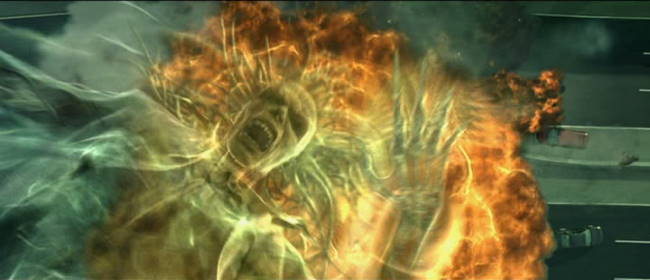
Overview: Matrix Reloaded, one of the most anticipated movies of 2003 provides a very interesting follow-up to one of the best, most influential movies in cyberpunk and all of Sci-Fi. Many have knocked this (and Revolutions more) for being a significant step down from the original movie, and to an extent they are in that the “newness” of the idea has worn off. But truly, it would be absurd to expect the Wachowskis to not use the universe they have already painstakingly created. In this sense, the sequels HAVE to provide a different sensation. In this sense, Reloaded does not disappoint. We get great performances by the Matrix leads, along with a number of truly terrific supporting roles. For this review, I’ll try to concentrate my comments more on the Sci-Fi aspects of the movies versus the religious narrative, as this also covered wonderfully elsewhere. I’ve also tried to use less well known screencaps on the first page of this review. To see some of the more popular Reloaded screencaps, go to page 2 of this review. Also, this review goes in line with my more in-depth assessment of the trilogy from a SciFi perspective:
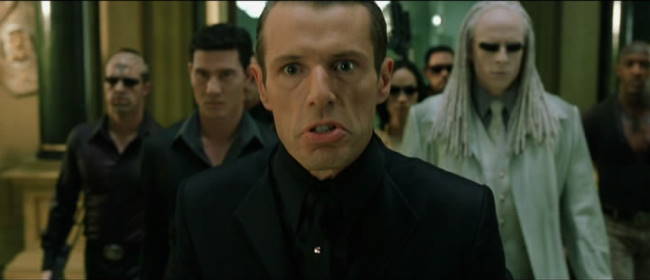
No “The Matrix Sucks/No It’s Great - You Just Don’t Understand!” Debates: Just a fair warning – if youre expecting Matrix sequel bashing, I’m afraid you’ve come to the wrong site. There are numerous places to read such banter if you’re interested. I absolutely love the sequels for a variety of reasons (some of which I explain below), but I really don’t mind in the least if you hate the sequels. Yet, for this movie, I’d really like the comments on this entry to be more related to the movie itself versus whether or not you hate the sequels. Believe me when I tell you I’ve participated in many more hours of discussion on this topic than I ever care to, and absolutely will not get into this in the comments section of this review. If you MUST engage in the “Matrix Sequels Suck/No - They’re Great, You Just Don’t Understand!” debate, please use this thread in the Meatspace.
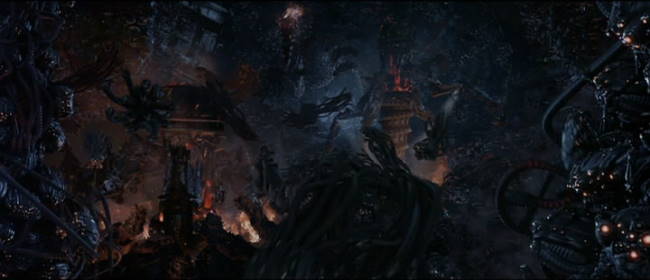
The Story: I’m going to go out on a limb here and guess that about 99.9% of you reading this review have already seen Reloaded, so I won’t spend much time on an overview of the story unless its specifically requested. In brief, Matrix Reloaded is the sequel to the Matrix, and is the second of three movies in the trilogy. In Reloaded, six months have past since the end of the Matrix, during which time, Morpheus, Neo and Trinity have been busting hump freeing massive numbers of battery people. In Reloaded, we get to see Zion, a return of Mr. Smith, and eventually, a fuller understanding of the nature of the Matrix and the Prophecy of the One.
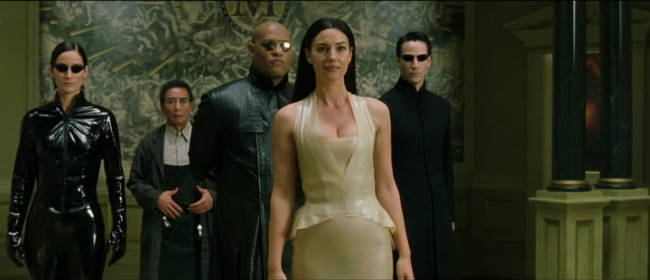
The Supporting Characters: One of the real strong points of Reloaded is the cool character additions. The best ones are of course the Merovingian (played magnificently by Lambert Wilson) and Persephone, played by the ultra-sexy Monica Bellucci in a totally hot see-through dress. When they are onscreen, both absolutely steal the scenes. Almost as terrific is the Architect (Helmut Bakaitis) and the blasé evil ghost twins (Adrian and Neil Rayment – who actually are twins) – they have to be up there as some of the best henchmen ever to grace the screen. Seraph (Collin Chou), Councilor Hamann (Anthony Zerbe), Link (Harold Perrineau), the Keymaker (Randall Duk Kim), and Niobe (Jada Pinkett Smith) all really add to the movie as well.
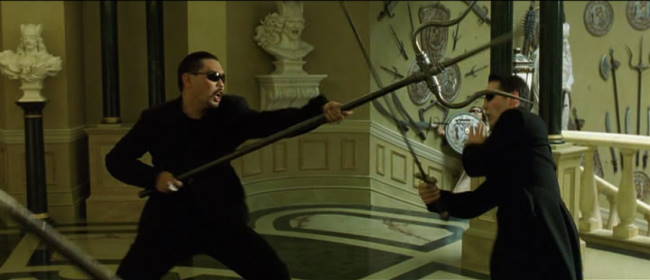
The Action: Reloaded is filled to the brim with awesome action scenes. In addition to some wonderful Woo-ping Yuen choreographed fights, we get one of the best highway chase scenes ever put on film. The Trinity motorcycle part in particular is just awesome. Truly though, serious credit has to go here to Keanu Reeves’ preparation and training for this film. By all accounts he was an absolute machine in terms of preparation. It really shows on screen. His wire work and martial arts scenes are just terrific (And no, I’m not comparing him to those in Hong Kong who’ve spent an entire career doing this stuff). The CG for the most part is absolutely top notch.
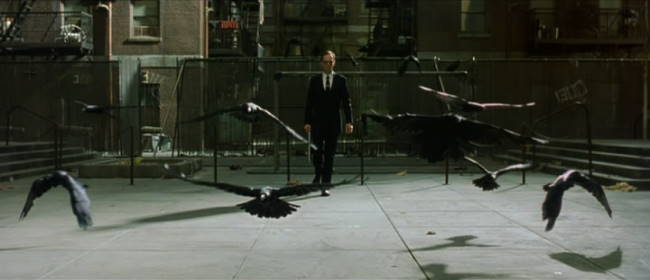
The Visuals: Matrix Reloaded has a lot more diversity in its visuals than the Matrix provided us. We have a few experimental shots like the graphic novel scene of Neo flying with the Moon behind him – and lots of yellows and greens. For yellows, we get rave scenes, explosions, and fights in a yellow weapons room. Greens, of course, still dominate the majority of the scenes – like the first movie, they are omnipresent in most low-light scenes. All in all, the visuals are incredibly diverse and interesting.
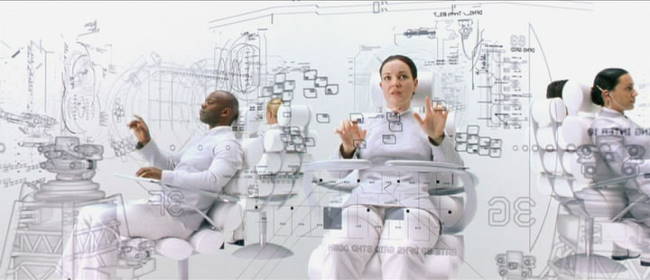
The Pacing: Matrix Reloaded starts off with a bang (literally) before getting into the story. We get a mixture of plot discussions, action sequences and philosophical breaks. But Reloaded is as a whole is definitely of a different style pacing than most movies. It and its sequel more closely resemble the approach taken in Oshii’s Ghost in the Shell, where there are philosophical and thematic discussions that are then played out in the action sequences. The ending clearly comes off as a cliff-hanger, which is to be expected considering this is the middle of a trilogy.
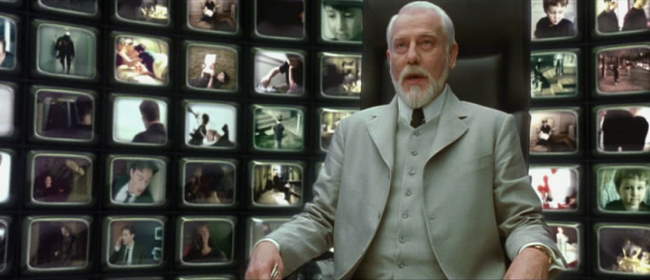
The Architect Conversation: The Architect conversation provides some of the best dialogue of the entire trilogy. This is a philosophical break, a plot buster, and more importantly, the major turning point in the trilogy. The Architect and his minions serve as the ultimate representation of a negative feedback (negating change from an initial goal state) control system. His whole purpose in life is to ensure a steady supply of power (electricity) to the Machine City. As the power is created off the electricity in humans, the Architect must develop a plato cave-like virtual reality simulation that provides humans with a believable reality. The Architect reveals the details of the control system that has kept the machines satiated with electricity for the past 600+ years. In this we find that the prophecy of the One is merely one more layer of control to maintain the status quo to handle the problems arising from freewill (more on this below). Unfortunately, something (or someone) has thrown a monkey wrench into his carefully laid plans. Neo has fallen in love, and in so doing, creates a personal connection with a human that is potentially larger than his overall connection with humanity.
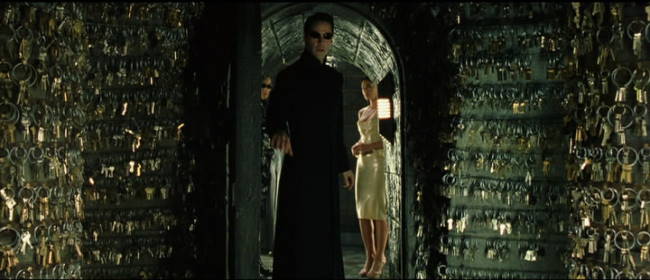
Freewill: Matrix Reloaded spends a good bit of the philosophical breaks discussing the impact of freewill on actions, decision making and on control systems. The Merovingian assets that without the “why,” freewill is merely a facade by those in power that is placed on the powerless. The architect who created the Matrix based on mathematical equations. While he has accounted for almost all anomalies, he had to develop a special periodic subroutine to address the issue of freewill. Because a very small subset of the population would reject the Matrix programming, there needed to be a way of handling this. His approach involves the creation of an external holding bin called “Zion,” which which he would let fill up with the problem battery people, and then every hundred years or so would clean out the holding bin and start again. Simultaneasly, Morpheus, who is unaware of this freewill control subroutine, sees the prophecy of the One as a deterministic journey - one which both reduces the power of freewill while supposedly saving Zion.
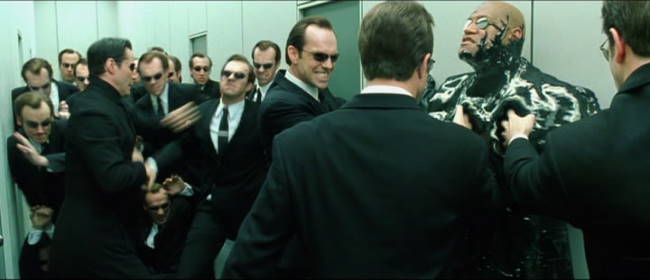
Positive Feedback Out of Control: From a cybernetic standpoint, Positive feedback, or the deviation from an initial goal state, plays a huge role in both reloaded and revolutions. In fact, both movies constitute an emergence and interplay among dueling feedback systems. The architect has created a negative feedback system that has been in force for at least 600 years. Yet now, the perturbations to the negative feedback control system are systemic – in fact, they constitute an initial kick in an entirely new direction. The study of cybernetics tells us that negative feedback systems are destroyed – often never to be repaired to their original state – if the upper or lower threshold values in the are exceeded. For instance, if the body temperature in a human exceeds 106 degrees Fahrenheit, the human will die. In the futuristic dystopia of the Matrix, this is the strategy the Oracle takes. The rationale is that unless the architect’s control system is rendered moot, the “ebony and ivory, living in perfect harmony” future (with machines and humans) the Oracle desires cannot occur.
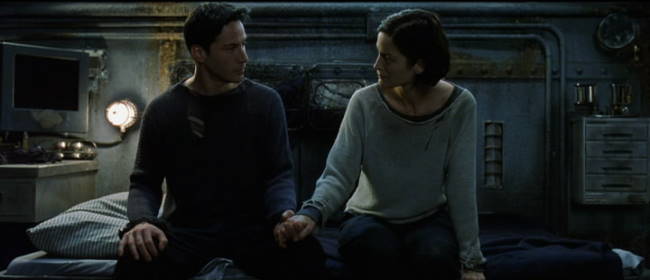
Elements of the positive feedback system, represented in totally by the Oracle and the causality she creates, include both a modification of Neo’s operant conditions and an intrusion into Mr. Smith’s deletion. Neo’s love for Trinity changes the outcome of the Architect’s freewill subroutine – instead of having only one real choice (saving humanity), Neo has a new choice – save trinity now and spend 24 hours trying to rescue Zion and humanity or continue with the control system which will wipe out Zion. Additionally, Mr. Smith has been transformed into a virus. When Neo destroys him in the first movie, Mr. Smith did not disappear – instead (as we find out in Revolutions), the Oracle intervenes and creates the new, viral Smith. While there is no resolution to this in reloaded, the context is set for the resolution in Revolutions.
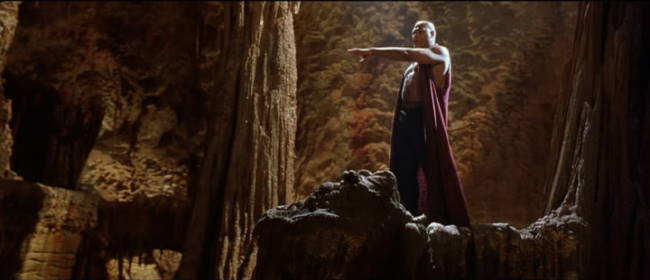
I Believe…: I believe this phrase (“I believe”) is used twenty times or more in Reloaded. There are times it fits perfectly, whereas others it seems to interfere with the dialogue. The scene where Commander Lock is discussing strategy with the Council is the most egregious example of this. Versus “I believe we need every ship…” it would have been far more realistic had he used a simple “We need every ship if we are even to have a chance…” The problem of course is the whole issue of whether or not the Commander and Council believe in the Prophecy of the One. As impending doom draws nearer, the tendency to place faith in supernatural explanations for salvation becomes too great to resist.
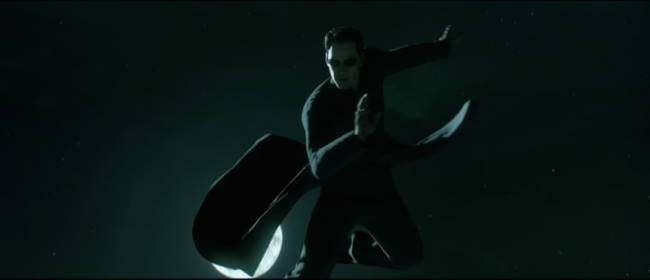
The Bottom Line: The Matrix Reloaded is a terrific follow-up to one of the most influential movies ever. The Wachowski brothers have provided a movie where the action is terrific, the characters are memorable, and the narrative is complex and interesting. Lawrence Fishbourne as Morpheus in particular shines here, which is great, in that is role is significantly diminished in Revolutions. While Reloaded suffers somewhat from being the middle movie in a trilogy, I think it handles this well. The ending provides us with a cliffhanger, which, at the time of release, sparked IMENSE numbers of interesting theories and ideas. I’m guessing most of you have watched Reloaded, so I feel strange giving a plug to watch it. All I can say is I love it.
Page 2: More Screencaps –>
~See movies similar to this one~
Movie Review By: SFAM
Year: 2002
Directed by: Kazuto Nakazawa & Naoyuki Yoshinaga
Written by: Chiaki Konaka
IMDB Reference
Degree of Cyberpunk Visuals: High
Correlation to Cyberpunk Themes: Medium
Key Cast Members:
Basil: Kazuhiko Inoue
Reiko Michaelson: Akemi Okamura
Rod Kimball: Somei Uchida
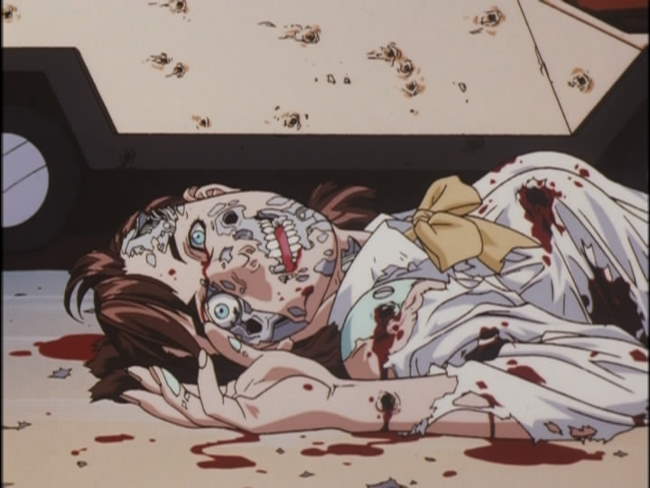
Overview: Parasite Dolls, another cyberpunk anime written by the prolific cyberpunk anime master, Chiaki Konaka (Serial Experiments Lain, Texhnolyze, Armitage III, Malice@Doll, and Bubblegum Crisis 2040), is a visually interesting, VERY adult OVA from the Bubblegum Crisis universe. The androids (called boomers) in this show are fully android (at least regarding their mental processes) unlike in other Bubblegum stories where they seem to be a combination of human and android. While this is a three part OVA, I really like that they are almost integrated like a movie, versus as separate episodes. Fair warning, you get gruesome deaths in the throws of sex, prostitution, lots and lots of gore.
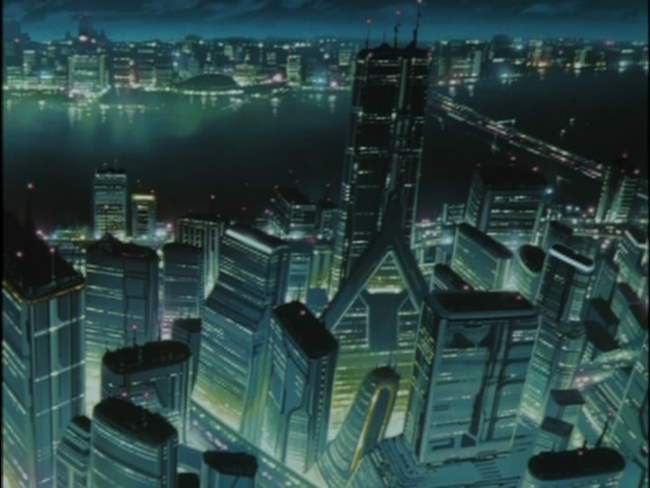
The Stories: There are three separate, interlinked stories on the Parasite Dolls OVA. At the start of the first story, set in the year 2034, where society has become a troubled mix of humans and androids called “Boomers.” The Genom Cooperation has created boomers to serve mankind in all aspects, from police support to sex dolls. Unfortunately, problems emerge, both with the boomers and with humanity’s reaction to their presence. A clandestine division of the Advanced Police (A.D Police) called “Branch” has been created to investigate human to boomer related crimes. The story follows “Buzz” Nikvest, a policeman with a troubled past, and his partners at the Branch division, which include a very helpful Boomer called Kimball and a stereotyped spunky, sexy, tough cop chick named Reiko Michaelson.
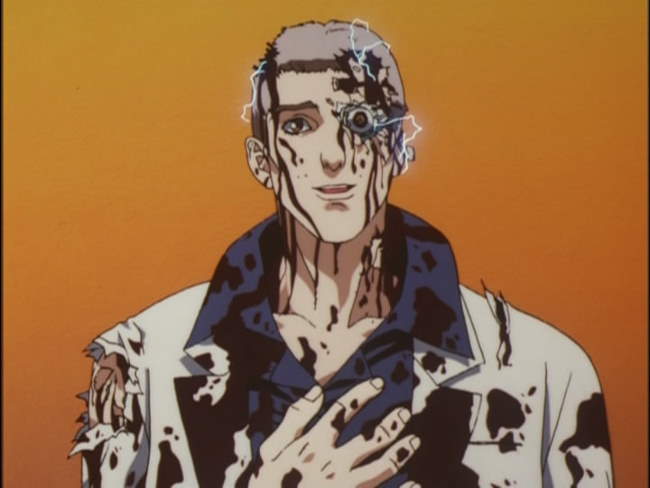
In the first episode, rogue boomers start randomly attacking and killing innocent humans. Buzz and company are brought in to investigate. During the course of their investigation, they find that things at the Genom corporation are not all above board. This story has some pretty cool visuals of shot-up boomers, and a few interesting
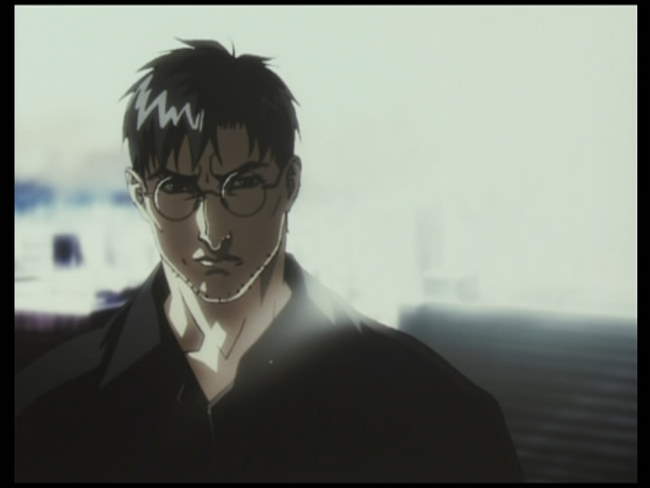
The second episode, which takes place a year later, involves a truly bizarre android monster called the “Boomer Crusher” and a very lifelike boomer prostitute who has feelings and has dreams. Unfortunately, the prostitute is being controlled in her dreams to cause some truly bizarre human deaths. We find out more in the third story of who probably created this monster, but it isn’t really stated in the narrative.
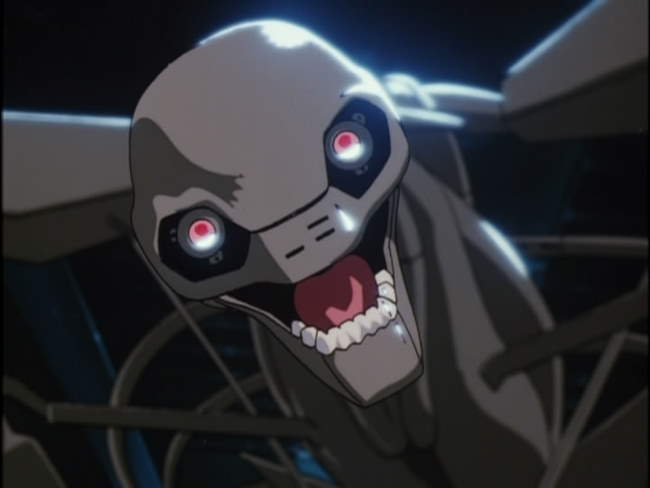
In the third episode, which takes place 5 years later, Takahashi, the head of Branch Division is missing. In searching for their missing box, Buzz, Kimball and Reiko find a connection between Takahashi’s disappearance and the recent spate of anti-boomer activity that has grown in recent years. Worse, as explosions go off all over the city, Buzz is framed as the fall guy. As the story unfolds, the viewer is left with the idea that all three stories are related to the same larger plot.
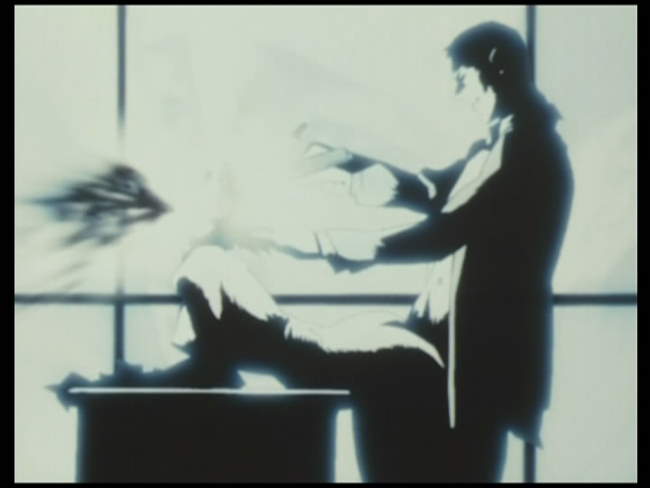
The Visuals: Parasite Dolls has a really nice diversity of looks, often emphasizing extreme shadows in single color light settings. Both blue and gray are used extensively for this, often yielding terrific visuals. In other cases, Parasite Dolls looks like a rather decent, but not spectacular anime. It does best when it strives for the edgy look. Had this been used throughout, Parasite Dolls could have come off as something bordering on special. As it stands, some parts really stand out, while others you almost wait to get through.
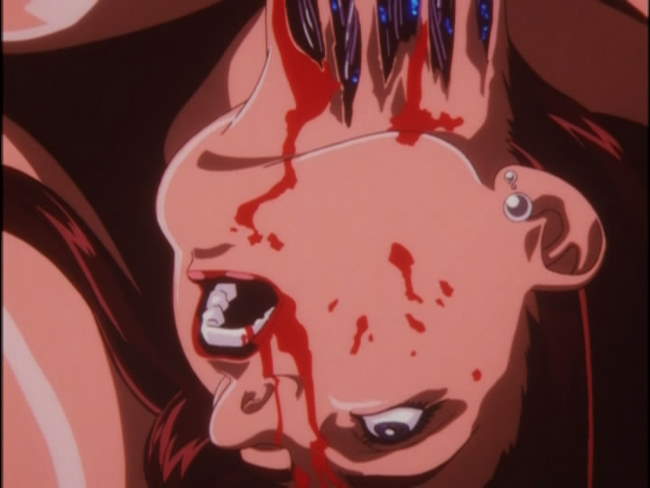
Boomers – property or unique individuals: Nothing new here – Parasite Dolls explores the continually explored question of whether androids are merely property or something more unique. Unfortunately, no new ground is traversed. Instead, the interesting aspects of this come from the seedy visuals themselves. There are a few scenes in Parasite Dolls where the visuals make a far more interesting statement than the narrative. These usually involve truly gruesome Boomer deaths.
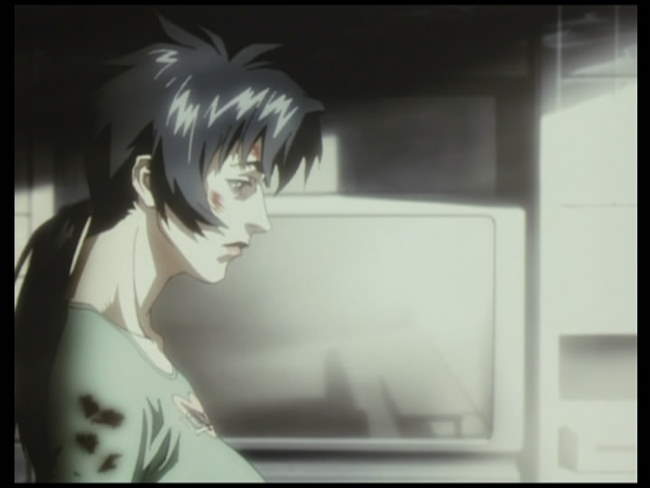
The Seedy Underground: A seedy feeling pervades Parasite Dolls. We get nudie bars, slovenly side-walks, seedy corporate meetings, and absolutely base human behavior. We have hot chick boomers continually debased and abused. Even the weird creatures that appear have an icky feel to them. The constant theme we see here are fallen boomers. They had so much potential, but…
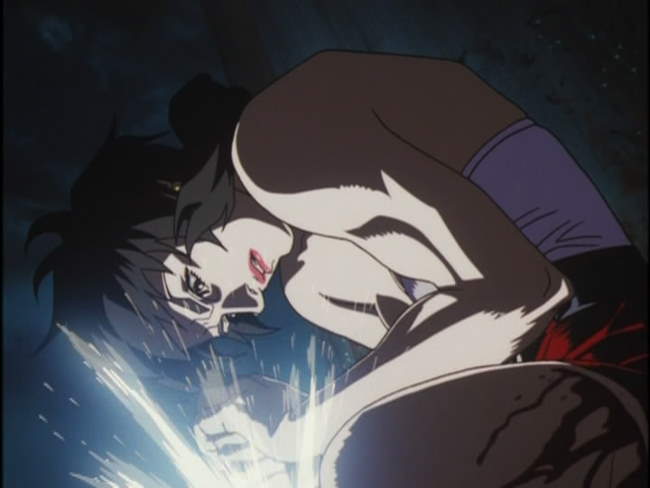
The Bottom Line: The stories themselves are somewhat uneven and problematic, but the visuals are interesting enough to make this worth a watch. While the narrative is more straight forward than many of Chiaki Konaka’s stories, it does require a few minutes thought to put the overall picture together – otherwise, all three episodes almost seem disconnection. Even though Buzz is a pretty interesting character, the rest of the characters we encounter are pretty much the cookie-cutter variety. Worse, as the episodes take place over a six-year time period, you would really expect to see growth in the characters, or at least changes in the nature of their relationships. Instead, the characters we encounter at the beginning are the same ones six years later. Still, for a 3 part OVA, Parasite Dolls is worth a watch for the visuals alone.
~See movies similar to this one~
Movie Review By: SFAM
Year: 2001
Directed by: Sogo Ishii
Written by: Sogo Ishii
IMDB Reference
Degree of Cyberpunk Visuals: High
Correlation to Cyberpunk Themes: Medium
Key Cast Members:
Dragon Eye Morrison: Tadanobu Asano
Thunderbolt Buddha: Masatoshi Nagase
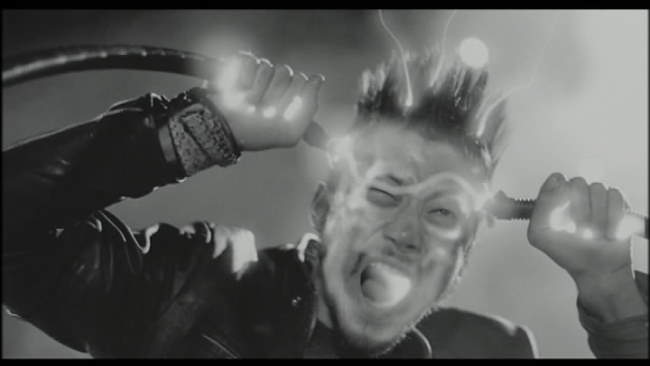
Overview: Sogo Ishii, master of the Japanese Extreme Cinema delivers a truly bizarre experience for us in Electric Dragon 80,000V. If you added the dialogue from this whole movie up, you probably wouldn’t get much more than a page or two. The story is told through visuals, and that said, the narrative itself isn’t all that deep. So why do I give the movie a decent rating? Simple – the visuals and the overall mood this film creates are absolutely unique. Electric Dragon 80,000V is first and foremost an experiential flick. The narrative definitely takes a back seat to the visual and sound integration.
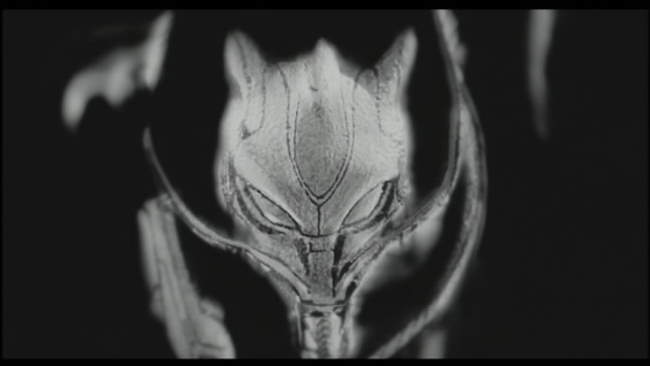
The Story: Electric Dragon 80,0000V follows the maturation of two kids who had traumatic experiences with electricity when they were young. One, Dragon Eye Morrison (played by Tadanobu Asano, who also stars as Kakihara in Ichii, the Killer), underwent electric shock treatment due to being violent as a kid – specifically, he endured 80,000 Volts of electricity. When Dragon Eye Morrison undergoes electric shock treatment, something in his reaction awakens the Dragon. The Dragon is the Eastern style dragon – one that’s embedded in all living things and the world at large. Dragon Eye Morrison’s connection with the dragon releases the rage within in, and thus, forces him to get more shock treatments. With each electric shock treatment, he develops a deeper connection with the dragon. By the time he’s an adult, Morrison can commune with reptiles (he owns a bunch), and has learned that playing REALLY LOUD guitar music (well, playing really loud anyways) is able to sooth the rage within him.
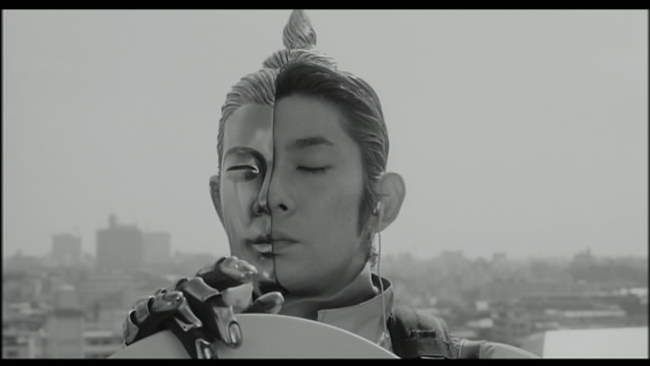
The other, Thunderbolt Buddha (Masatoshi Nagase) got electrocuted with 20 million volts while attempting to climb a power-line tower. The electricity is so high that half of his body becomes encased in metal – and in fact his personality is as split as his body. One side of him is trying to kill himself, while the other is deviously listening in on all electric conversations within his vicinity. It’s not to hard to figure out that Thunderbolt Budda is the bad guy in this modern Godzilla story.
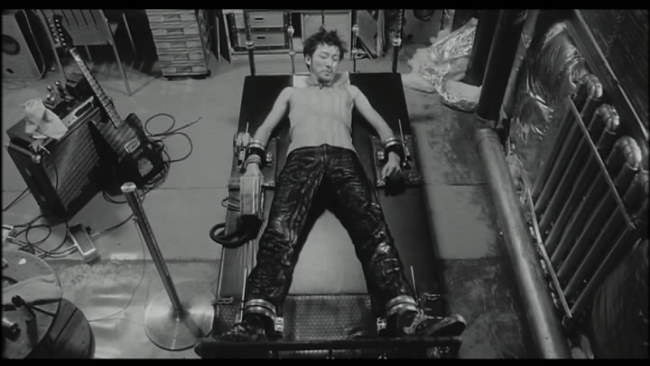
By the time they are both adults, somehow Thunderbolt Buddha, who spends his time attached to a satellite dish, scanning the city, finds out about Dragon Eye Morrison – worse, he decides that the world isn’t big enough for the both of them! So Thunderbolt invades Morrison’s apartment and kills some of his lizards and takes others prisoner. Sure enough, Dragon Eye Morrison figures out who the culprit is and they meet at high noon! From there – it. is. ON BABY!!!!
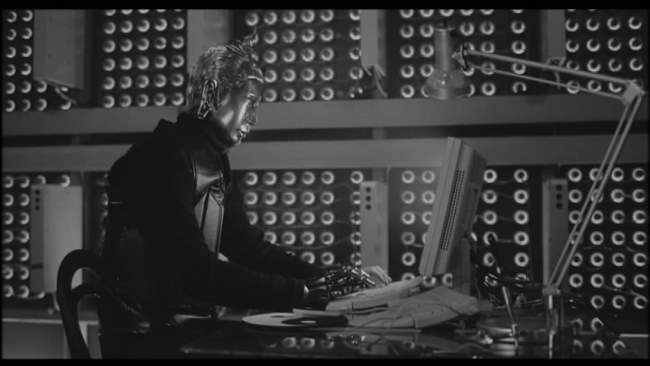
What the Fuck is This Movie About? Yes, at first glance, this movie appears to be pretty shallow and non-sensical, and it may just be. But I like deeper meanings, so allow me to intuit. OK – assuming there is any meaning one can derive from this movie, my wild ass guess is it is this – Dragon Eye Morrison represents the Dragon on earth personified, whereas Thunderbolt Buddha represents modern technology. At first glance, modern technology appears stronger than the earth (20,000 volts to 80,000), yet, due to his ability to bring the full might of the dragon to bare, he’s able to stand up to modern technology. What’s interesting about this theory is the reversal of fortunes: Dragon Eye Morrison gets transformed to merging with the Dragon (earth) due to the detrimental use of technology on him, whereas Thunderbolt Buddha is transformed by a natural occurrence – lighting. In a sense, both grow up reacting against that which transformed them. Or, um, my theory is full of bunk – you make the call. 
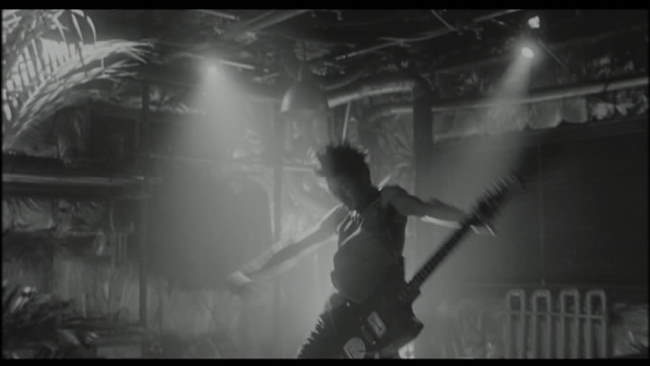
The Sound: As tightly integrated as can be, Electric Dragon 80,000V links massively loud and distorted guitar sounds with the kinetic visuals. This is really the true genius of Ishii’s work. Like all Japanese Cyberpunk movies, Electric Dragon provides an assault on the senses. Unlike most, the assault in this case isn’t as strong on notion of humanity itself, but is instead an assault on you, the viewer. To really experience this movie in the way it was intended, I STRONGLY recommend absolutely cranking the sound. If you don’t do this, you really will lose out on the mood this picture tries to set, and really, will not get the attraction
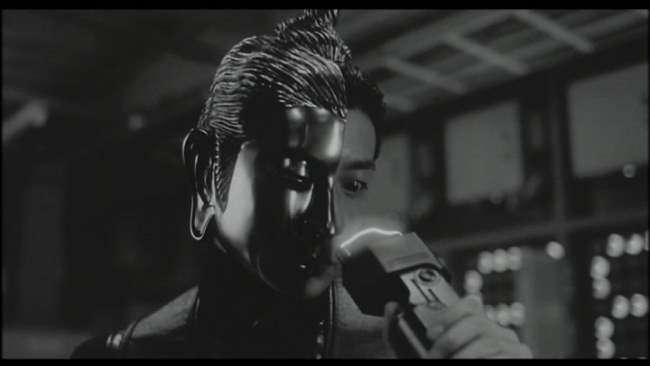
The Visuals: Electric Dragon 80,000V is really rather sedate for the first half. While well shot, the visuals aren’t really that noteworthy from a Japanese Cyberpunk standpoint. But the second half is FILLED with a bevy of truly bizarre shots. Electricity integrated with humans is the theme, and it is explored in a variety of ways, though showing various forms of electricity to kinetic shots of volts coursing through our lead characters. The second half uses the same style of stop-motion animation we get in Tetsuo - The Iron Man. While the movies are radically different, the movement of these two films is pretty similar.
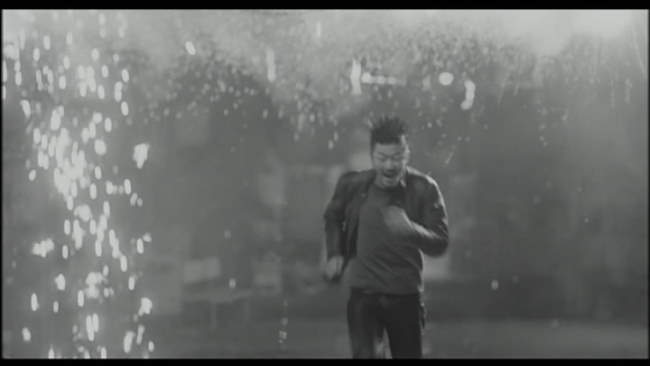
The Bottom Line: Electric Dragon 80,000V is clearly an indulgence in extremes. The mood brought on by the sounds and visuals far outweighs what little exists of the narrative. In the end, Electric Dragon 80,000V is either a movie you really dig or absolutely abhor. For this reason, I find it pretty difficult to give a solid rating, so I’ve gone with 7 stars - which implies that it’s a good movie, but one that some may not like. The entire thing is barely 50 minutes, so if you find yourself hating it, not to worry, it will be over soon. If you do like it though, Electric Dragon 80,000V has solid replay value.
~See movies similar to this one~
Movie Review By: SFAM
Year: 1997
Directed by: Luc Besson
Written by: Luc Besson & Robert Mark Kamen
IMDB Reference
Degree of Cyberpunk Visuals: High
Correlation to Cyberpunk Themes: Low
Key Cast Members:
Korben Dallas: Bruce Willis
Leeloo: Milla Jovovich
Jean-Baptiste Emanuel Zorg: Gary Oldman
Father Vito Cornelius: Ian Holm
Ruby Rhod: Chris Tucker
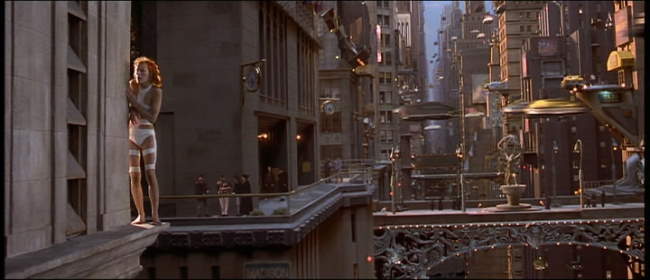
Overview: Some movies are just absolute absurd fun – so fun that you end up watching it endlessly. The Fifth Element is that way for me, and is a movie I’ve seen around 20 times or so. The tone of the movie is too light-hearted to be considered a real cyberpunk movie, but like Tank Girl, we can consider this a cyberpunk comedy. The characters are all a hoot, and the movie never takes itself seriously – in fact it’s almost always over the top. Many of the cyberpunk themes still exist in Fifth Element, although, again, they are enacted in a light-hearted way. It’s the visuals that really bring Fifth Element into the cyberpunk subgenre.
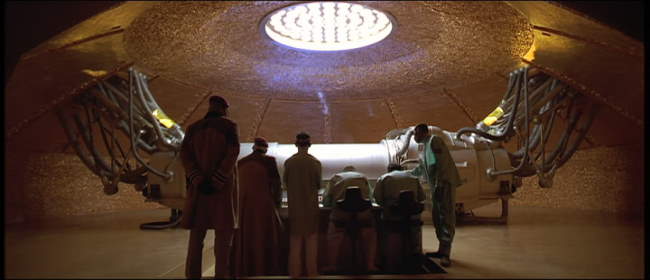
The Story: 217 years into the future, ultimate evil is again coming to destroy the earth. Ultimate evil takes the form of an absolutely massive malevolent ball of blackness that is on a course to destroy earth. Every attack the Federated Territories try only makes it larger. It turns out that a group of priests has been keeping the ancient technology necessary to destroy ultimate evil – four stones representing the 4 elements, which surround a fifth element. In this case, the fifth element is s beautiful girl (Milla Jovovich), reconstructed from the remains of a small DNA sample.
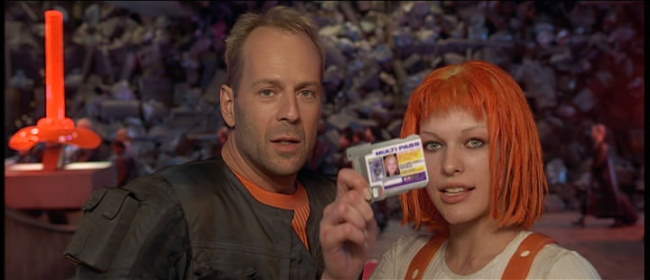
“Leeloo Dallas, Multi Pass”
Korben Dallas (Bruce Willis) is a down and out highly decorated former military commando, now turned failing cabbie, who has a beautiful girl named Leeloo (Jovovich) fall into her cab – literally! The authorities are after her, as it turns out she has escaped those who recreated her. She can’t speak English yet she figures a way to ask for help. After she asks, Korben Dallas takes her to the priest, Father Vito Cornelius, who recognizes her as the Fifth Element, and promptly kicks Korben out.
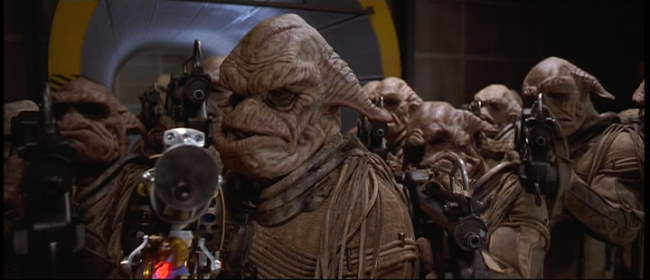
From there, things get crazy. The military approaches Korben for a secret mission to retrieve the stones necessary to stop ultimate evil. The stones are hidden with a famous Diva who is performing at the famous floating hotel, Floston Paradise. At the same time, Zorg, an evil corporate CEO (Gary Oldman) has hired a group of Mangalores (evil, ugly aliens) to retrieve the stones. Simultaneously, Father Vito Cornelius and Leeloo also find a way get to Floston Paradise to retrieve the stones. Things get even weirder when the famous radio host, Ruby Rhod (Chris Tucker), an outrageous guy with a penis-head hairdo hosts the Floston Paradise experience with Korben as his guest!
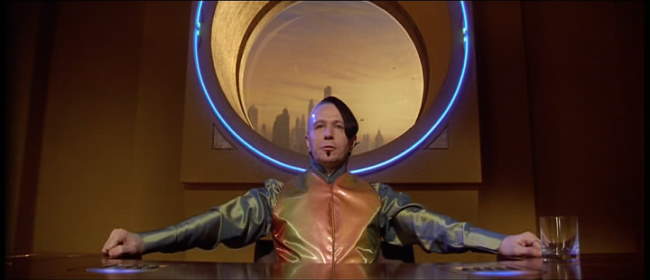
The Acting: All the main characters in the Fifth Element are quirky and memorable. Bruce Willis really works as a former hero, now on his last leg. Jovovich is beautiful and otherworldly. Tucker is a riot! This movie really got him known (Rush Hour made him famous though). And Gary Oldman as Zorg is flat out awesome as a completely crazed power-hungry evil doer with a quirky sense of style and salesmanship. Truly, Besson did a great job in casting this.
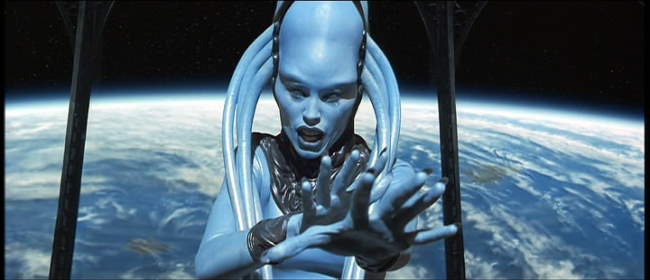
The Visuals: The Fifth Element totally rocks in the cool futuristic visuals department. The colors include dark yellows with neon blues for the backgrounds, saturated blue scenes and orange clothes for the leads. But its the city-scapes, reminiscent of Lang’s Metropolis that are especially memorable. They flat out nail a far out vision of the future. Additionally, we have airports with 30 foot tall trash heaps due to a garbage worker strike, fully automated, ultra-processed McDonalds, deaf rock stars
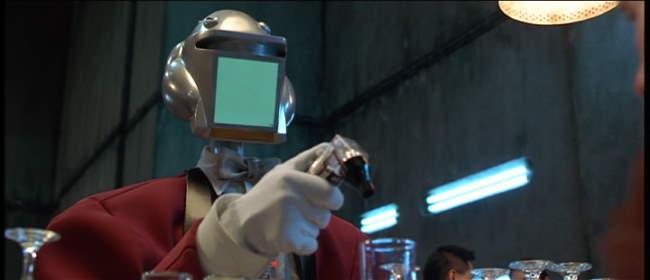
The Editing: The editing in the Fifth Element is just terrific. The splicing of the various story strands, as crazy as they are, flow wonderfully. In discussing the missing stones, the simultaneous, intermixed dialogue between Leeloo and Father Cornelius and Zorg with the Mangalores are just one terrific example of this; the Diva opera singling intermixed with Leeloo’s fighting is another. With the amount of stuff going on here, this could have ended up a disaster. Sylvie Landra, who also edited Leon – the Professional, deserves heaps of praise for this.
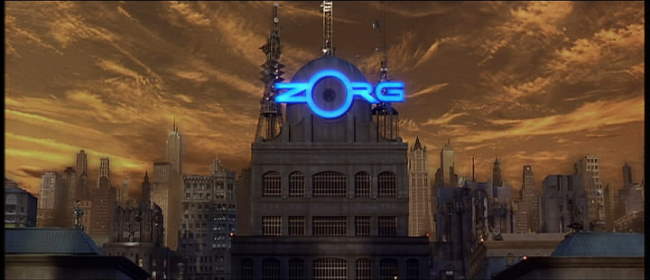
The Fifth Element Cyberpunked Future: Dropping the crazed fantasy aspects of the stones and ultimate evil, The Fifth Element gives us a pretty dire view of the future. Cities are built high to escape the constant layer of smog that coats the surface; corporations are all-powerful; governments are impotent; fashion statements have gone seriously awry; cockroaches are used as intelligence, surveillance and reconnaissance systems - but at least we still get cheap Chinese food! Plus robots now do all our menial work!
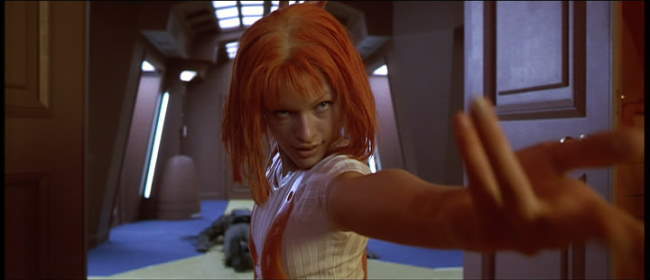
The Bottom Line: No, the Fifth Element is not intended to be taken seriously. Still, this movie is just far more enjoyable than it has any right to be. The action and romance are fun, the characters are unforgettable, the story is entertaining, the music is great, and the visuals are marvelous! The Fifth Element has been in my regular heavy watching rotation since it came out. Give this a watch if you’re looking for a witty futuristic cyberpunk action-comedy flick.
Go to Page 2: More Fifth Element Screencaps–>>
~See movies similar to this one~
Movie Review By: SFAM
Year: 2004
Directed by: Shinji Aramaki
Written by: Masamune Shirow (Manga), Haruka Handa & Tsutomu Kamishiro (screenplay)
IMDB Reference
Degree of Cyberpunk Visuals: Very High
Correlation to Cyberpunk Themes: Medium
Key Cast Members:
Deunan Knute: Ai Kobayashi
Briareos: Jûrôta Kosugi
Hitomi: Yuki Matsuoka
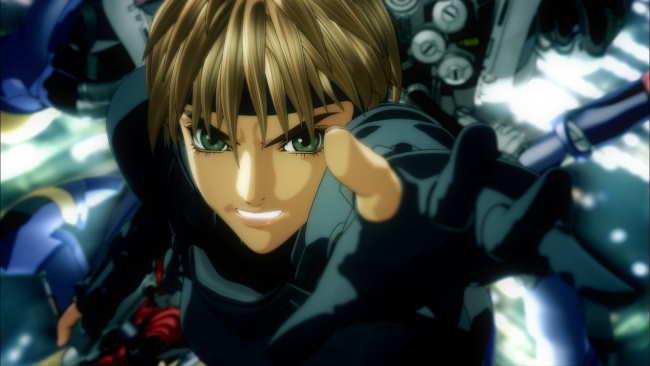
Overview: Masamune Shirow’s Appleseed recently got a second anime treatment. The last was in 1988 – this time, in 2004, the anime is done up in eye-popping 3D graphics. With a budget of only 10 million as compared to over 90 million for a movie like The Incredibles, we shouldn’t be expecting too much. Surprisingly, we get far more than expected, especially with regards to the wonderfuly rendered backgrounds. While the animation is interesting enough, the story is more problematic. So too are the change in the feel of the characters. This is really where the original version succeeds far better than Aramaki’s version.

The Story: Appleseed takes place in the year 2131, a war-ravaged dystopian future where most all of human society is in ruins. Over two years after the last war, the only example of advanced human civilization is a newly made city called Olympia, which has been engineered to be a created as a perfect refuge from the rest of the world. Over half of the city’s inhabitants are comprised of bio-engineered “biodroids,” which are human-like beings designed to serve specific roles in the society. An all-knowing computer named GIA supports the city council in controlling all aspects of city life.
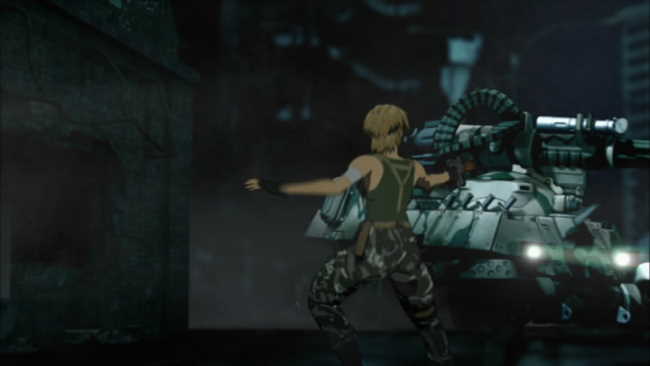
Deunan Knute, a fighter extraordinaire has been living alone in the wastelands, not realizing that the war is over. She is beset by two warring groups of fighters, one of which who is trying to kill her, and the other group, which rescues her and takes her to Olympia. There she is re-acquainted with her long lost lover, Briareos, who now has been transformed into a cyborg after his body was lost in the war. She is tasked to join “ESWAT,” a special mecha-enabled police force that keeps order within the city. Deunan also befriends a biodroid named Hitomi, who shows her around the city. Unfortunately, Deunan barely gets a chance to settle down before the assassination attempts on her life start.
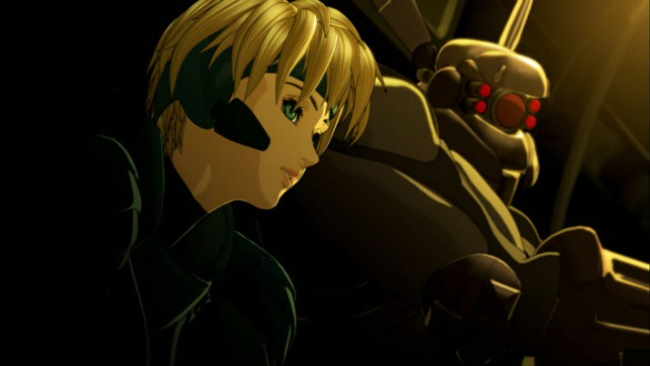
Duenan quickly learns that she has been dropped in the middle of a power struggle between humans, who are concerned that the biodroids secretly aim to exterminate them, and biodroids, who worry the same about the humans. Somehow, Deunan has become essential in this struggle, yet it has nothing to do with her fighting capabilities. It turns out that her parents, before dying, developed a method for biodroids to reproduce, which would make them almost exactly like humans. But this research was lost long ago. Now, Deunan has become a pawn for both sides of this struggle, and worse, it appears as if her ex-lover, Briareos has chosen sides.
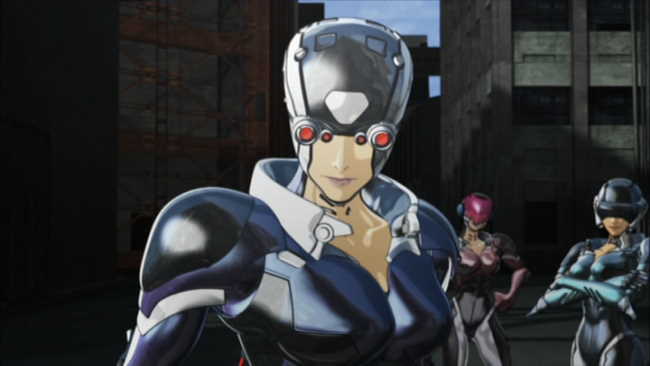
Unfortunately, the story in this version of Appleseed is problematic at best. There are too many sub-plots that obfuscate the key points. The myriad of loose ends introduced that are never followed up on. Gia, the sentient computer that runs Olympus is the probably the worst casualty. We get introduced to her, and, if you know something of the Appleseed story from the Manga, you expect to see lots more than what actually ends up being conveyed. In the end, the plot centers on a simple theme of racism. This is a shame as there were so many interesting cyberpunk aspects of Olympus that get short-circuited.
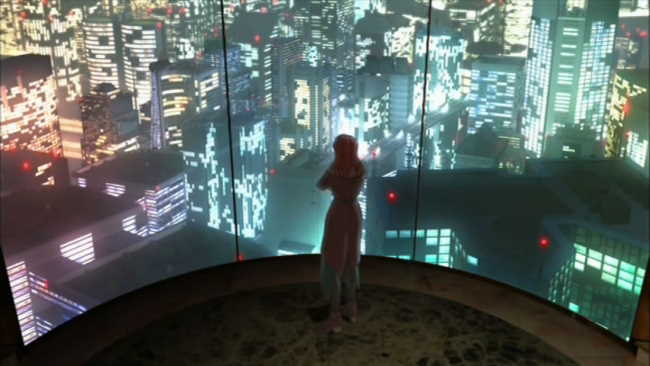
The Animation: Appleseed’s backgrounds are wonderfully rendered. This more than anything accounts for the majority of the “wows” Appleseed received. They are done in a way that allows 3D camera maneuvering, so as to allow you to see the same scene from multiple angles, and at times, even provides Matrix bullet-time effects. For the most part, the 3D CG overlaid with 2D cell shading really works. It’s an extension of the idea we saw in Malice@Doll, only with far better rendering tools. The machines look especially awesome. Both the Gunhed style tanks at the beginning of the movie and the platform sentinels at the end. Unlike many cyberpunk movies, there isn’t a dominating color palette in Appleseed, but the color scheme seems to stick more often than not to light and dark shades blue-greens, with yellow & browns in transition scenes.
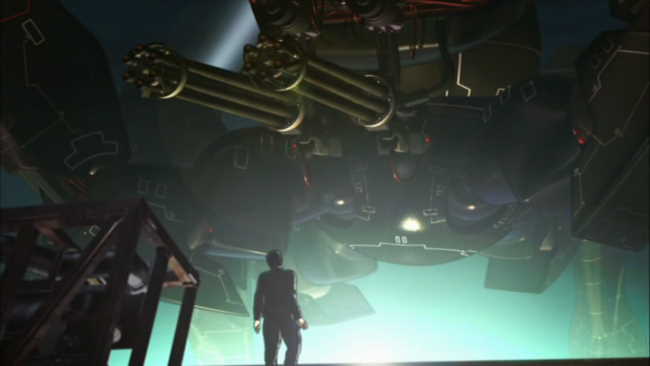
In terms of the characters, only Deunan Knute really looks polished. Her body movements, facial expressions and general actions really work. The rest, especially the human characters, often look stilted in their moments. Hitomi, their biodroid friend, is especially problematic at times. This might be due more to the motion-capture techniques they use, which work wonderfully for the city, but not so well for the characters. Also, I really dislike the way they animated the hair. The hair on the humans in the 2004 edition look like something out of Reboot. However, considering the budget, I think they made the right decision in spending scarce resources on Deunan. Had they just made everyone look slightly better, Appleseed would have faltered horribly. By at least making Deunan polished, they developed a star that fit right alongside their wonderful backgrounds.
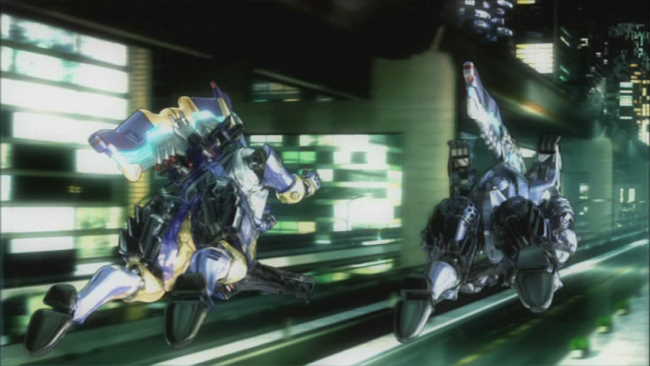
The Sound: Many times throughout the anime, Appleseed plays more like a music video than it does a movie. The modern heavy rock beats worked well for the action scenes. And truly, the action scenes are where Appleseed excels. There, the 3D positional sound, the music accompaniment and the 3D CG graphics are at their absolute best. The accompanying score really wasn’t all the memorable, but at least served up the slower paced moods fairly well.
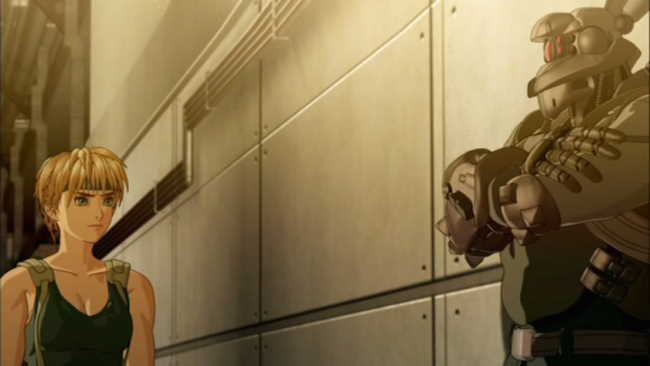
Differences From Shirow’s Work: While both animes deviate from Masamune Shirow’s Appleseed Manga, Aramaki’s version is the most egregious. While the 2004 version starts outside of Olympia as the Manga does, it only has Duenan there, whereas in the Manga has both. This version introduces a new dramatic twist of Duenan and Briareos getting back together for the first time in two years. While this in itself isn’t bad, the side-effect is: these two characters are no NOTHING like the Manga. The Duenan Knute and Briareos of Shirow’s Manga, and of the 1988 version, are precursors to the Ghost in the Shell’s Motoko and Batou. Here, Briareos is a moody, lost soul trying to deal with his cyborg body, and Duenan is far more vulnerable than tough. The playful chemistry we see between these two both in the Manga and the 1988 anime is completely missing here. For those who aren’t familiar with the Manga, this probably won’t bug you, but it certainly sapped some of the enjoyment out of this movie for me – so much so that I’m dropping a star off the review for it.
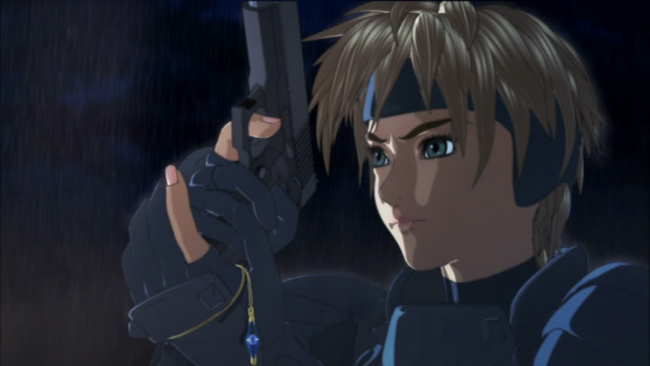
The Bottom Line: Appleseed is definitely worth seeing for the visuals alone. While some of the characters don’t work, the Duenan, the machines and the action scenes work wonderfully. Unfortunately, the story doesn’t equal up. Too many elements are introduced and then discarded in favor of a truly simplistic storyline. They could have done better. Also, as I mention above, this is not the Deunan and Briareos I’ve become familiar with – these characters are different from both the Manga and the earlier anime. This bugged me enough to drop a star from the review, but you might not mind so much.
Page 2: More Screencaps –>>
~See movies similar to this one~
Movie Review By: SFAM
Year: 2001
Directed by: Steven Spielberg
Written by: Brian Aldiss, Ian Watson & Steven Spielberg
IMDB Reference
Degree of Cyberpunk Visuals: Very High
Correlation to Cyberpunk Themes: High
Key Cast Members:
David: Haley Joel Osment
Gigilo Joe: Jude Law
Monica Swinton: Frances O’Connor
Prof. Hobby, the Visionary: William Hurt
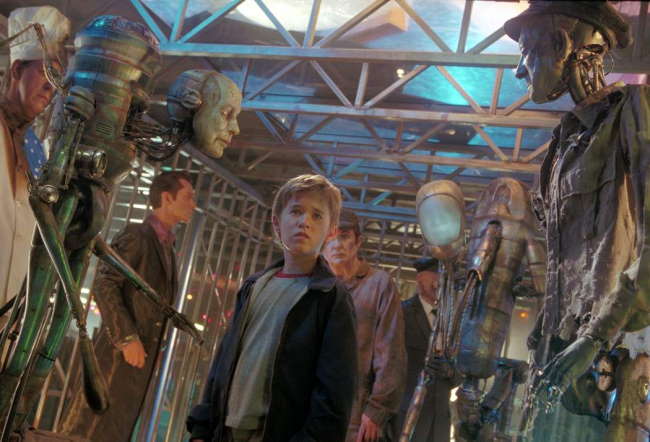
Overview: Originally convieved of by Stanley Kubrick, Spielberg took the reigns of this wonderful Pinocchio tale done in cyberpunk. This story is about a robot who wants to be a “real boy” so that his mother will really love him. Like Pinocchio, he goes on a journey of discovery. Although there are a few over-the-top scenes, the FX is awesome and the acting is wonderful. AI definitely inspires discussion if nothing else.
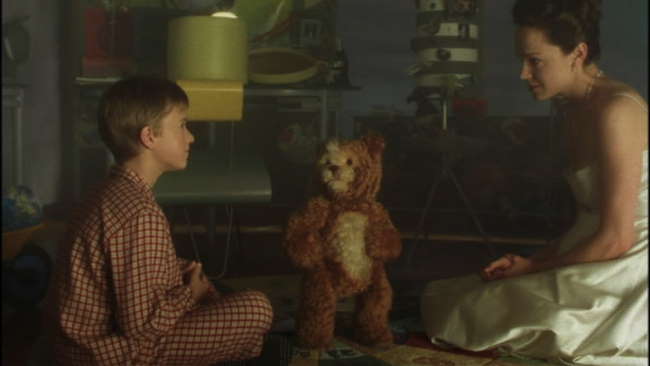
The Story: Set in a near future where global warming has led flooding of all the coasts, and a general breakdown has occurred in many parts of the world. Robots, called Mechas, are common in society now, and perform a variety of functions. Unfortunatley, there is widespread public outcry against their very existence. The focus is on a single family, where a mother has essentially lost her son, who now hangs on to life in cryogenic freeze. Her husband convinces her to get a new model mecha to replace their son – this one becomes hard-wired to its owner and experiences real love and emotion. After accepting their new mecha, a child named David, the family’s life seems complete – until their real son miraculously recovers from his illness.
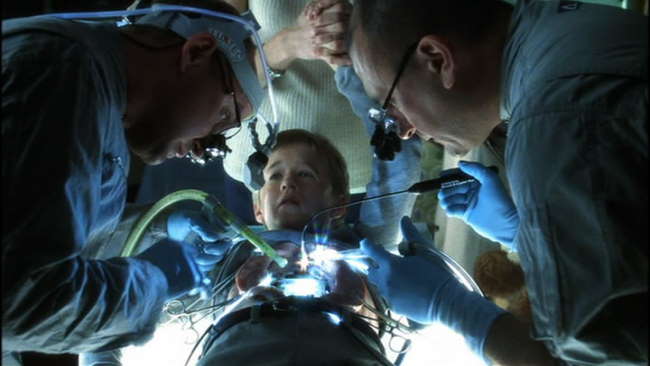
Their real son feels threatened by David, and after a sequence of incidents, David’s mother is forced to send David back to his maker for destruction. But while driving him to his death, she cannot bring herself to follow through, and instead sets him free. In a traumatic breakup, David’s mother warns him of the dangers of the outside world before leaving him alone with just his Teddy toy. David, having been read Pinocchio, decides that if he can find the Blue Fairy, he can convince her to turn him into a “real boy.” Along the way, he encounters Gigilo Joe, who helps him on his journey.
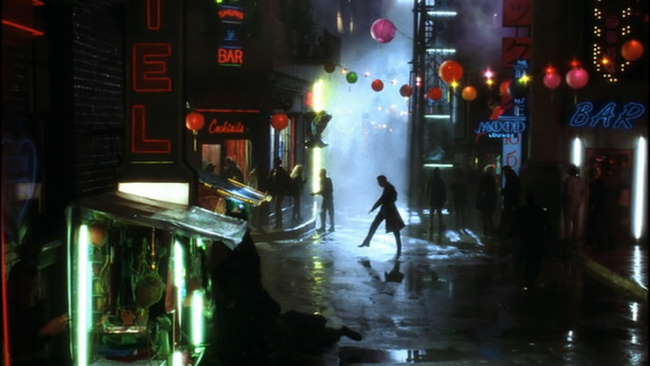
The Acting: The acting in AI is consistently terrific. Haley Joel Osment puts in a performance you’d never expect to see from an actor so young. He is utterly believable both as a mecha, and as his journey proceeds, seemingly transforms into a regular acting boy. Jude Law puts in a terrific performance as Gigilo Joe – one that almost transcends the movie itself as a memorable character. Frances O’Connor also delivers a fine performance as David’s mother, as does William Hurt as David’s inventor.
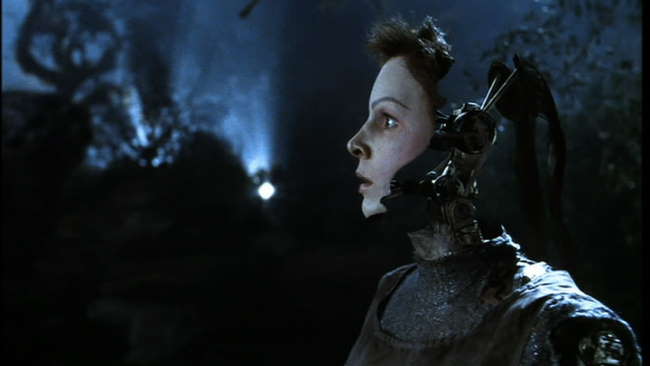
The FX: The visual effects in AI are still among the best that’s ever been put on film. The mechas (robots) look incredibly real – far more real than should be possible. There are many different kinds of mechas, many of which are represented here, but none are better than the Nanny. She is breathtaking. The entire front-end of the movie gives us a very normal set of surroundings. Other than the cars, and minor mecha parts, we aren’t dazzled by the upfront effects. This makes the second half all the more impressive. When David goes outside, things change dramatically. From the robots, to the city-scapes to the destroyed New York, this AI is a visual feast. To top it off, the Teddy Bear is maybe my favorite robot character of all movies.
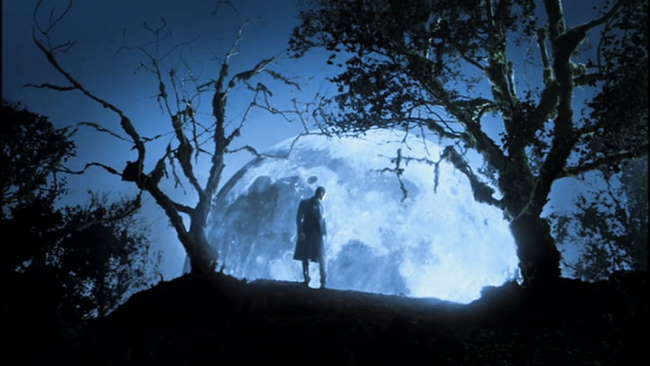
The Score: John Williams is as awesome as ever in creating the score for AI. He is able to capture the feeling of the dregs of humanity along with an almost heavenly sense of love and contentment. The score really brings the movie together in places that with something lessor it might not have worked.
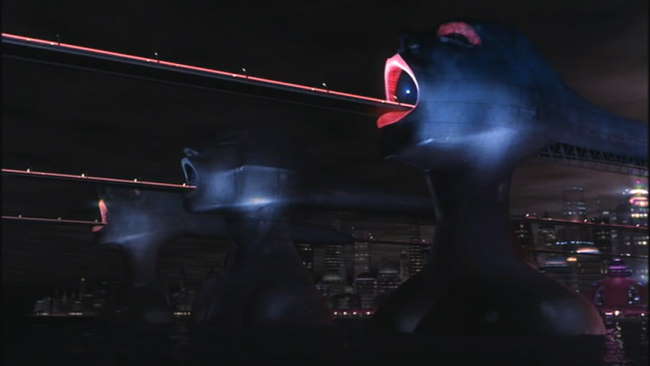
Kubrick versus Spielberg: AI is a strange movie in that it encapsulates a harsh Kubrick-style future while at the same time has a story that lends itself to Spielberg’s Capra-like tendency for the emotional mushiness. In watching AI, rarely do the two tendencies meet up well. We either have the dystopic craziness of the Flesh Fair or the serenity of the beginning. We also see dramatic changes in pacing. In some parts, we have a very slow, deliberate movie, whereas in others, it seemingly breezes past key scenes.
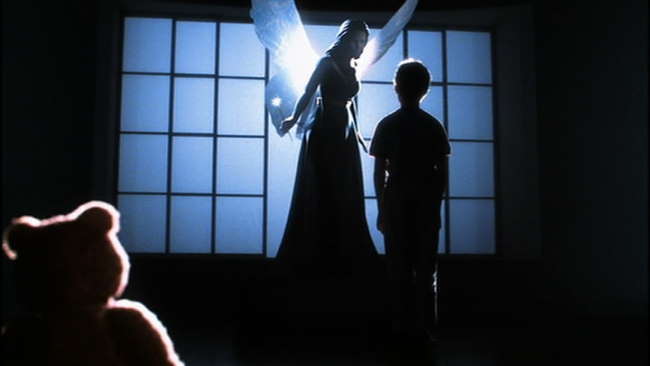
Some thoughts on the ending: Many folks who generally like the movie end up hating the ending. I don’t have this issue - in fact I like the ending, but I do understand the sentiment. The ending really does drop into a completely different movie altogether. In effect, it becomes the fairy tale that David pursues the entire movie. But because I KNOW the ending engenders discussion, I am concerned about spoilers in the comments below. PLEASE don’t post spoiler thoughts - if you do, your comment will be deleted. Instead, I’ve created a thread in the meatspace to discuss the ending of AI.
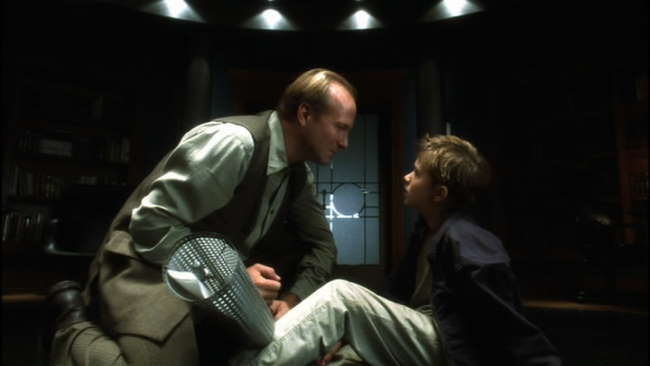
The Bottom Line: AI is a visual feast of dystopia and human morals run amok. As the same time, it’s a beautiful love story about the best of humanity. Many have issues with the ending, although, it works fine for me. While the actions in the Flesh Fair are bit outside believability, overall, the story is very well done. The CG is among the best ever on film (check out page 2 below if you want to see more screencaps). It doesn’t serve to astonish us, but instead, attempts to integrated seemlessly into the film. The acting is terrific, especially from Haley Joel Osment (David the robot boy) and Jude Law (Gigolo Joe). On top of this, we get a very interesting portrayal of a future with sentient robots who do not have any rights. One can almost see the Animatrix’s Rennaissance occurring shortly afterwards.
Go to AI, Page 2: More Screencaps –>>
~See movies similar to this one~
Movie Review By: SFAM
Year: 1995
Directed by: Peter Chung & Howard Baker
Written by: Peter Chung et. al.
IMDB Reference
Degree of Cyberpunk Visuals: Very High
Correlation to Cyberpunk Themes: High
Key Cast Members:
Æon Flux: Denise Poirier (voice)
Trevor Goodchild: John Rafter Lee (voice)
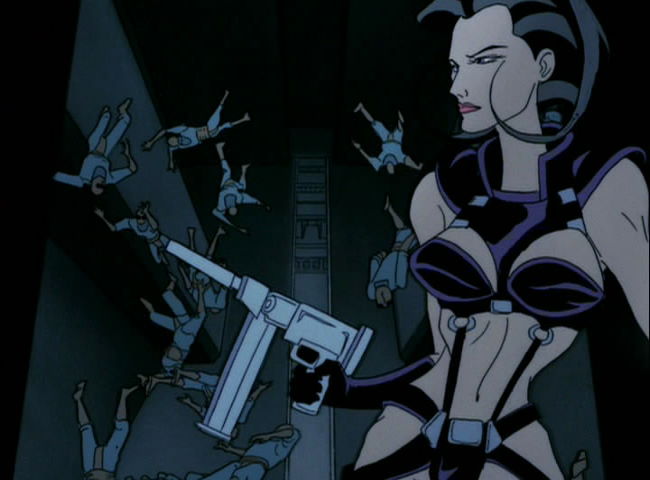
Overview: Aeon-Flux, the brainchild of Peter Chung (also the writer/director of the terrific Animatrix short, “Matriculated”), is one of the really innovative and unique animated shows to come out of the United States. We really have to thank MTV for allowing this show to get produced, and then, after realizing that they just couldn’t control it, for letting it go on unfettered for a second season. Aeon-Flux is not meant to be a coherent whole – this postmodern cyberpunk show is as nihilistic as they come.
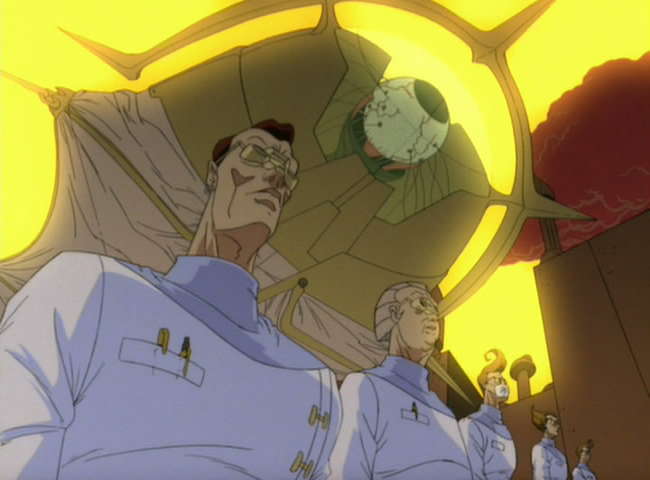
The Story: Aeon Flux takes place in a truly bizarre near-future setting, in which genetic engineering, body modifications, and excessive self-gratification are the norm – yet these extremes take place in a controlled surveillance society. Nearly all events take place in the utopian city, Bregna, which is controlled by a supreme oligarchy. Trevor (voiced by Vampire Hunter D’s John Rafter Lee), one of the two central characters, is a prototypical mad scientist who, at first seems to have little regard for anything other than his own perverted desires. As the show goes on, we find that he is in fact truly besotted with Aeon Flux, who, in many ways is his complete opposite. Aeon Flux (voiced by Denise Poirier) represents the forces of anarchy, and is continually involved in fucking up Trevor’s carefully laid scheming. Unfortunately for Aeon, she too cannot resist Trevor’s guile, which just as often, leads to her downfall.
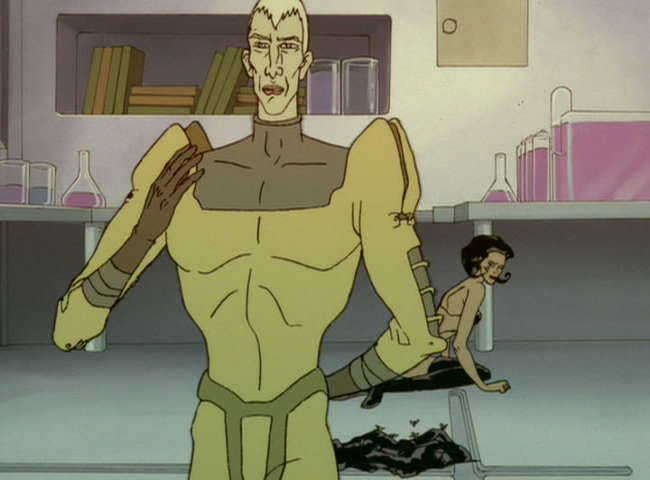
Virtually every episode is different in Aeon Flux, but all of them deal with a strange, fast-paced plot that deals with espionage in some way. Episodes usually have the feel of a chess match, where Aeon and Trevor match wits over completely strange and esoteric plots. More often than not, nobody wins. In fact, unlike most shows, the winning and ending itself is rarely important. This is not what the shows are about. More important is the mood, the feel, and the atmosphere that exudes from the visuals, the dialogue and the score.
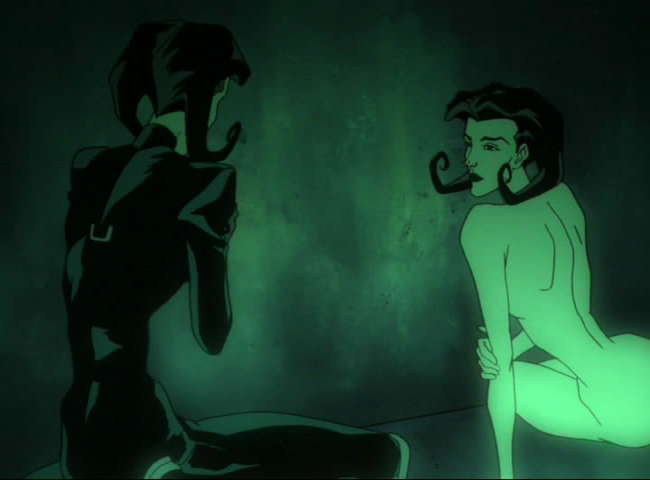
Spoiler – Aeon Flux Dies…A lot! Well, OK, it’s not really a spoiler. It’s more a fact of the show itself. Unlike most shows, in this one, the star dies regularly. Early on in the long shows, Trevor clones Aeon Flux, so thematically, there is now an infinite number of Aeons just waiting to bite the big one. And while there’s now a “rationale” for the deaths, this isn’t really the point – Aeon Flux isn’t meant to hold together that way. It’s almost as if each episode is completely it’s own show. But if she dies, rest assured it will happen in a truly innovative and gruesome way. It could be drowning in a vat of poisen, getting dropped out of a plane, being eating by bizarre genetically modified creatures, or, well, you get the idea. .
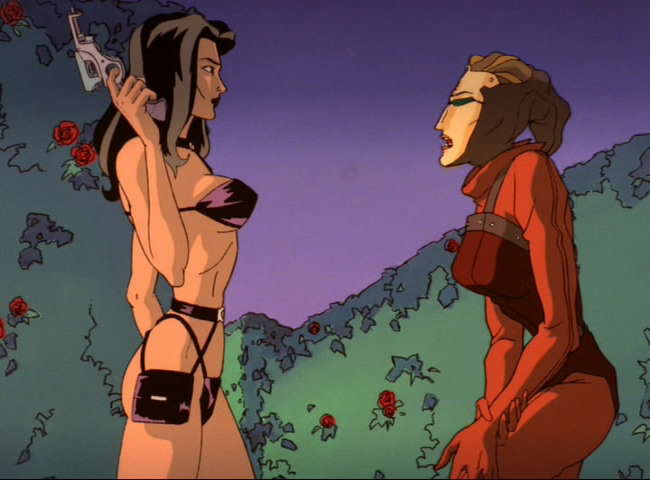
Aeon Flux – the Ultimate Anti-heroine? In many ways, Aeon Flux comes across as the ultimate anti-heroine. While she clearly knows right from wrong, and generally tries to stop the worst abuses, Aeon is an ultra-acrobatic, top-notch action/espionage heroine who works for herself. She’s just as likely to take an assassination job as she is to stop a horrid virus from killing mankind. Did I mention she’s drawn up in ultra-hot, skimpy clothes, and likes to have sex a lot? In this way, she really does qualify as a more female than female character (usually cyberpunk reserves these for cyborgs and androids). Most interestingly, because of Aeon Flux’s propensity for dying, you never know whether or not she’s going to make it through alive, or even whether she’ll complete her mission (she seems to fail almost as much as she succeeds). This really does add an excitement to the episodes.
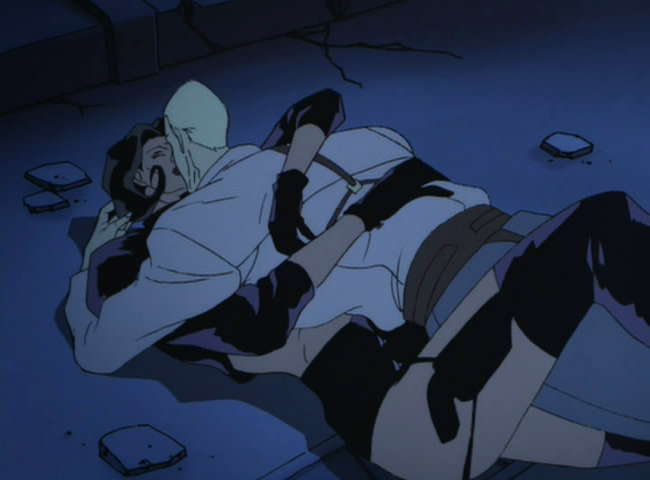
The Love-Hate Relationship: Aeon-Flux and Trevor have a complete love-hate relationship. Even when they are bent on killing one-another, there is always sexual tension, which while often consummated, never leaves the two characters. Every episode gives us yet another chance to explore their relationship in a completely bizarre way. Trevor is definitely Aeon’s Kryptonite. More often than not, his presence alone is enough to make her botch her mission. However, this doesn’t stop Aeon from ruining most, if not all of Trevor’s take over the world plots.
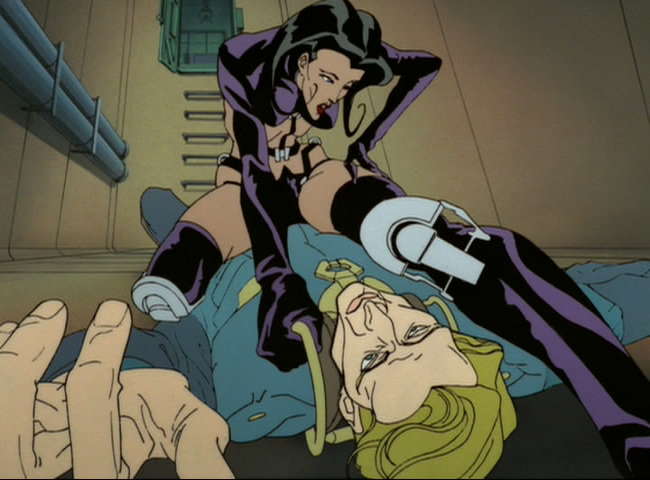
The Visuals and Cinematography: Aeon Flux gives a number of different looks as the show progresses. Perhaps my favorite are the perspective shots such as the one above. We also get lots of wide angle shots, strange close-ups, gradients, and a number of truly surrealistic sets. Unlike most cyberpunk, Aeon Flux doesn’t really adhere to a single dominating color scheme – but to the extent it does, the blues are more highlighted than the rest. Usually, each episode will have a unique theme that dictates the color choices – often they will take a color palette (oranges, greens, etc.) and detail it out in interesting ways. Some episodes are truly surreal in nature, while others are straight neo-noir. The overall goal is always to innovatively create a far-out intense atmosphere wrapped up in a tightly paced, no-nonsense near-future espionage show. More often than not it succeeds.
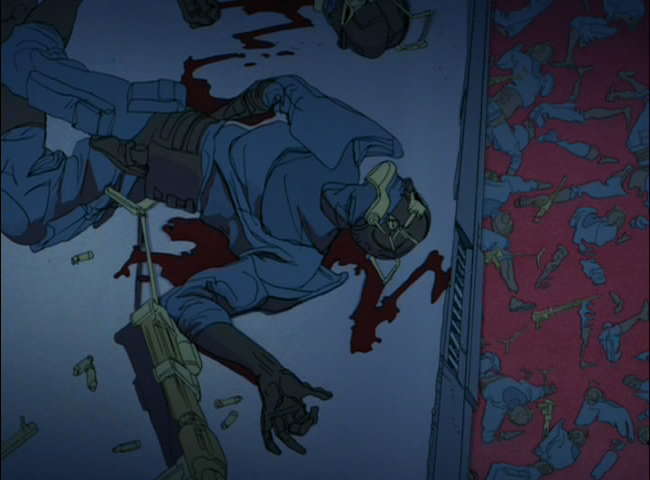
The Violence: Much to MTV’s initial chagrin, Aeon Flux is NOT a kids show. This is an adult cartoon in every way possible, including the intense violence. While the shorts are more violent than the half-hour episodes, Aeon Flux is consistently violent. There are leg amputations, deaths by gunshot, poison, insects, creatures, aliens, viruses, et cetera (often to Aeon herself!). Blood and gore are often just a scene or two away. All of this serves to strengthen the near-future but otherworldly atmosphere of Aeon Flux.
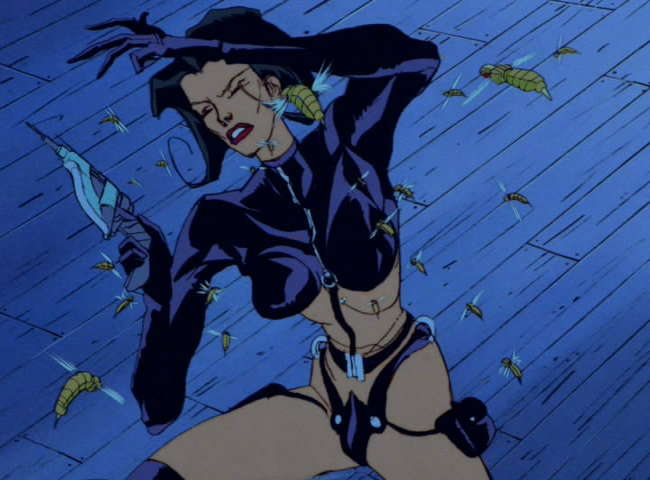
The Gadgets: Aeon-Flux is filled with gadgets of all flavors. Most common are body modifications and “biopunk” elements (just learned that word ). Body modifications include external spinal cord implants, leg jumping implants, conversions of limbs, eye implants, and various compartmentalized bodily storage areas. Genetic engineering is a huge theme in Aeon Flux, far more than the cyber-aspects. We also see repeated instances of cybernetically modified insects who’s function is to inflict a virus of some kind into a target population (Now we know where DARPA got the idea from!). Needles are also a recurring them, and show up everywhere from guns, to security implements, to, um, the operating table.
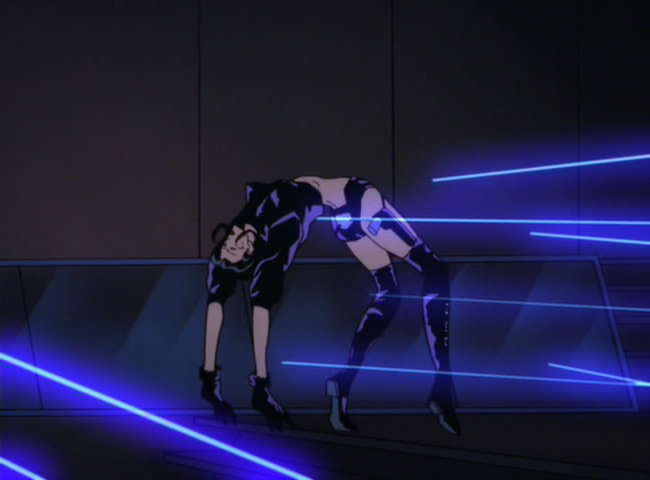
The Bottom Line: Aeon Flux is one of the really creative shows to come out of United States Television. This show validates the purpose of cable TV – we get to see talented folks like Peter Chung let lose their creative energies to produce something truly unique. And while I normally don’t spend too much time talking about the DVD features, I must on Aeon-Flux – the DVD set is flat-out terrific. I almost put it up there with Errol Flynn’s Robin Hood and The Kino edition of Metropolis as one of my favorite DVD productions of a long-lost show. The commentaries, featurettes, and extras are all terrific on the Aeon Flux DVD. If I had any qualms about whether to give Aeon Flux 8 or 9 stars, the incredible quality of the DVD set answers it for me.
More Aeon Flux Screencaps on Page 2–>>
~See movies similar to this one~
Movie Review By: SFAM
Year: 1987
Directed by: Paul Verhoeven
Written by: Edward Neumeier & Michael Miner
IMDB Reference
Degree of Cyberpunk Visuals: High
Correlation to Cyberpunk Themes: Very High
Key Cast Members:
Officer Alex J. Murphy/RoboCop: Peter Weller
Officer Anne Lewis: Nancy Allen
Dick Jones: Ronny Cox
Bob Morton: Miguel Ferrer
Clarence Boddicker (Crime Lord): Kurtwood Smith
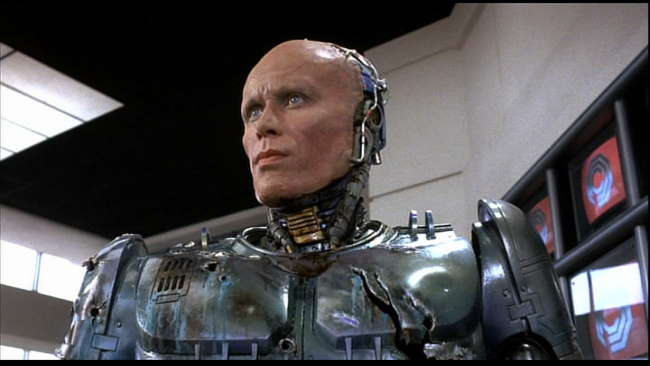
Overview: One of the truly unique movies in the cyberpunk genre, Robocop seems to be slowly receding from our conscious. No longer (in the US) is it carried at places like Best Buy. This is truly a shame because Robocop offers us one of the best instances of near-future cyborgs on film, and in the process, raises some pretty interesting questions. One top of this, Robocop offers some really fun satire along with an in-your-face realistic violence tone throughout that only adds to its mood.
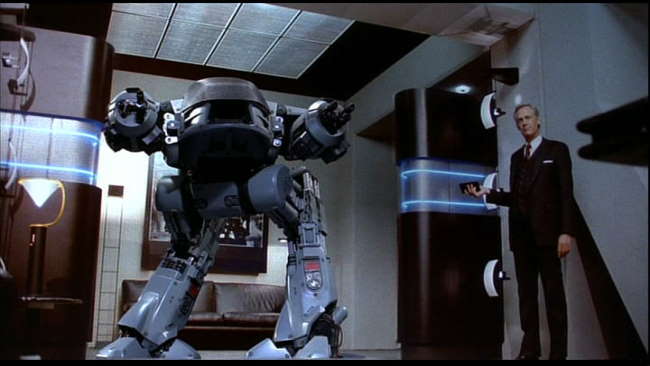
The Story: In a very near-future setting, general law and order has broken down. In the crime-ridden city of Detroit, Omni Consumer Products (OCP) has taken over the public safety duties. To cut costs, they have decided to explore options for automating the police force. One option supported by Dick Jones (Ronny Cox) the number 2 guy at OCP, involves the development of a fully automated mobile weapon system called “ED 209.” While ED 209 is an absolute badass, it screws up in the final demo and ends up peppering one of OCP’s employees in the process.
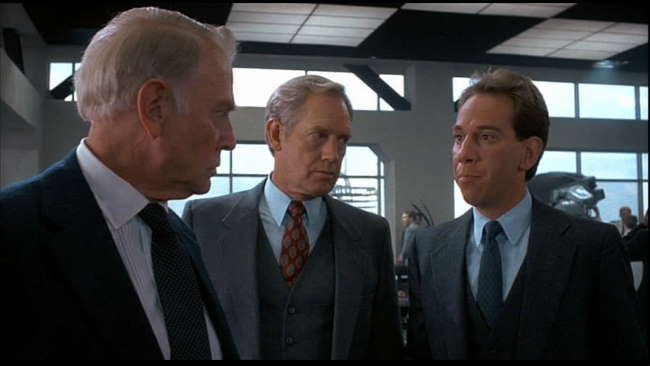
Enter up and coming executive, Bob Morton (Miguel Ferrer). Bob takes ED 209’s demise as an opportunity to convince the CEO to give the Robocop project a try. This involves taking a “just-dead” cop, and embedding the key parts of his body (brain, lungs, heart, etc.) into a robotic body that interfaces and “controls” the mental processes through controlling prime directives. Detective Murphy (played wonderfully by Peter Weller), who has just died in a gruesome death at the hands of Detroit’s crime lord (Kurtwood Smith) becomes the new “volunteer.” His memory is erased, his limbs are removed, and then becomes OCP’s corporate property as their latest innovation.
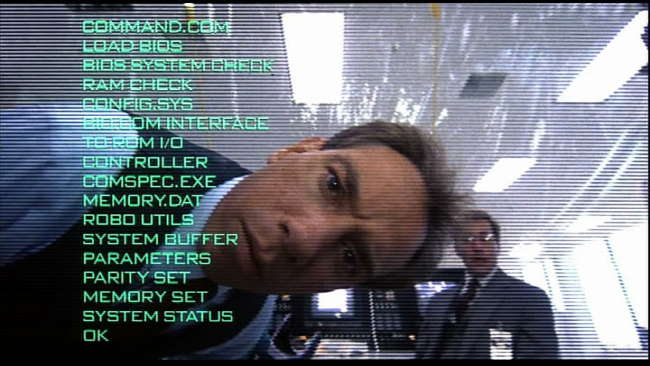
Murphy is transformed into a fully encased crime fighting machine. Robocop is released on the streets to start kicking ass. Unfortunately, Dick Jones doesn’t take his defeat gracefully, and begins to cause trouble both for Robocop’s creator, Bob Morton, and finally for Robocop. It turns out that OCP’s plan for managing detroit’s crime situation isn’t all above board, as there appears to be some linkage between OCP and Detroit’s crime lord. Robocop’s troubles get even worse as he begins to remember who he was in a past life.
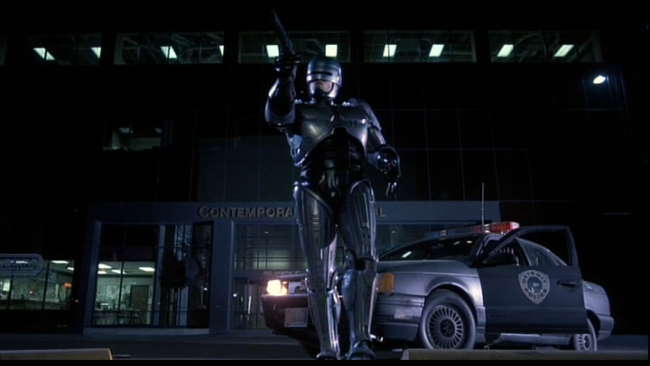
The Satire: Verhoeven is known for having an off-beat sense of satire. In a technique later used for Total Recall and Starship Troopers, Robocop does this primarily through its news reports and commercials. These, along with the corporate greed thematics transforms Robocop into a social commentary on the 80s excesses. The Commoditization of society permeates every aspect of human life in Robocop. Corporations are inherently evil and humanity is a cheap sales pitch. Like Starship Troopers, you’ll continually catch yourself smiling at the commercials and news reports, as Verhoeven really has a talent for this type of satire.
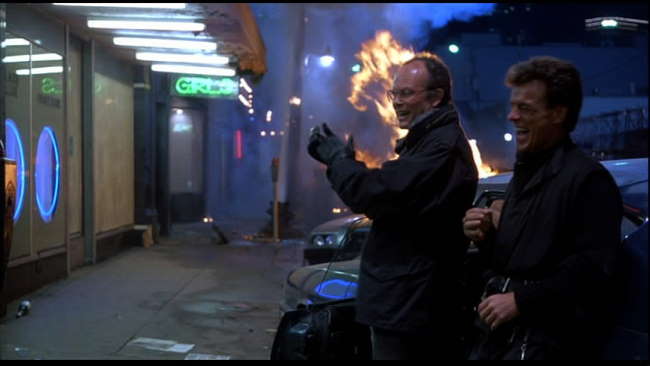
The Violence: Fair warning – Robocop is an extremely violent movie – so much so that upon its initial release, they had to cut two seconds of violence to prevent from receiving an “X” rating. Nothing is held back here, as Verhoeven continually strives for hyper-realism. We see limbs getting blown off, blood spattered faces and walls, and in-your-face gore of all varieties from beginning to end. However, the violence doesn’t stick out as a sore thumb – instead it serves to give the near-future city a nourish realism feel. In short, it works within the context of the narrative and surrounding visuals.
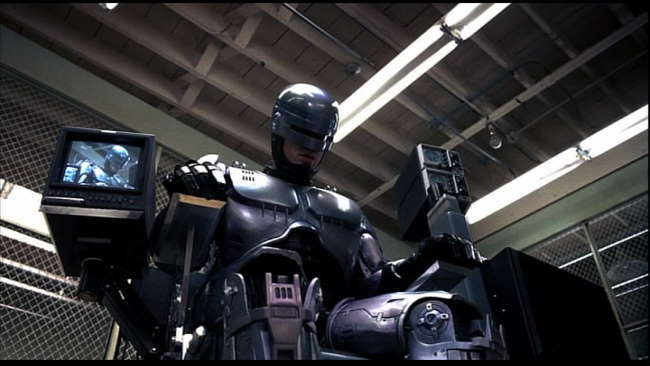
The FX and Set Designs: While Verhoeven gives us a somewhat futuristic city, he seems to err on the side of looking “normal.” We see this most clearly in the Ford Taurus police cars (which were brought in after everyone agreed the futuristic police car designs looked too tacky to be considered). However, the set designs are all wonderfully constructed, and all seem work well with one-another. The ED 209 looks terrific, and the stop-motion animation for it generally works. Robocop’s exterior design does look hoaky at first, but you eventually get used to it. On the other hand, Robocop without his helmet looks flat-out awesome.
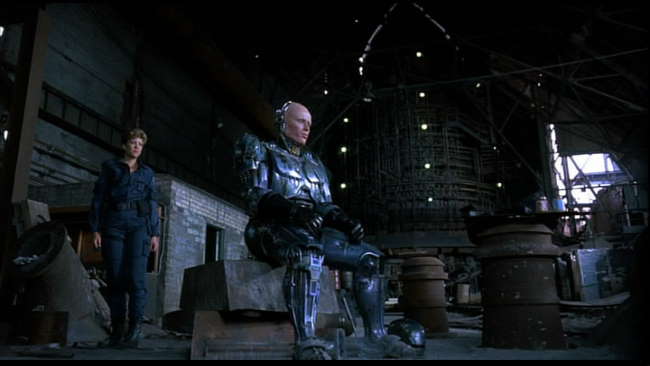
The Cyborg Questions: Robocop/Murphy give us a rich set of questions to ponder relating to cyborgs, the integration of programming with human minds, and in determining ownership after death.
- Cyborg and Humanity: As Murphy begins to realize who he was, and worse, what he’s become, the question asked is what degree of Murphy’s humanity remains? Murphy’s partner, Anne Lewis (played by Nancy Allen) serves to surface these concerns, as she still thinks that Murphy is inside somewhere. Yet, every aspect of humanity has been taken away from Robocop – he doesn’t have a home, but instead returns to a borg-like podchair at night to regenerate. Even if Robocop eventually considers himself human in some sense, it’s no longer clear what that even means. At best, Robocop is part of that strange category we call “post-human.”
- Man-machine interface – Robocop Style: Robocop gives us an interesting look at human brain-matter that has been fully integrated into a cybernetic body. Even more interesting though is the notion that external programming could limit the functioning of the human brain from controlling its new cyborg casing. If we think about it, this isn’t as far fetched as it may initially look: similar to how firewalls block “targeted” information from either entering or exiting a network, Robocop’s programming ensures the human mind adheres to the prime directives. But while the prevention part seems possible, the “directive” nature of the rules seems dubious, as does the erasing of his memory. These perhaps, are far harder to do without destroying the “cop experience” they so desired by picking Murphy in the first place.
- Dixie Flatline Construct Concerns: Similar to the Dixie Flatline Construct in Neuromancer, for all intents and purposes, Murphy is dead prior to being transformed into Robocop. At best we can consider him a zombie as his brain matter was re-animated after death. But like Dixie Flatline, he can think and perform sensemaking. Also like Dixie Flatline, he is limited by programming constraints. However, unlike Dixie Flatline, Robocop can still “feel.” So the question is this – if we develop the capability to re-animate someone’s consciousness after death, do they have the same basic human rights as they did when they were alive? Or are they the property of the corporation who revived them? Even weirder, could corpse’s estate executor (or spouse, for that matter) “sell” the corpse’s consciousness to a third party? If this is so, could your conscious be sold after the fact to pay off unpaid debts? Truly, the questions are mind-boggling!
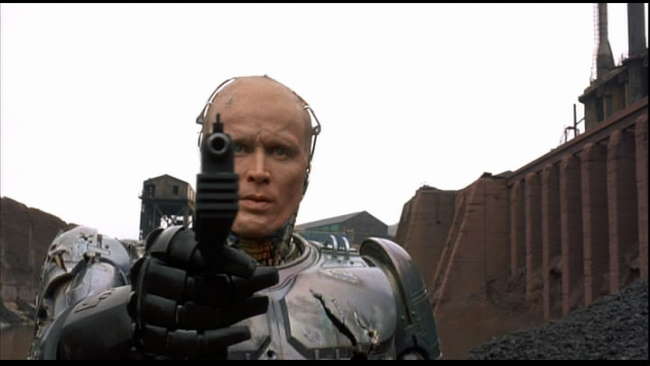
The Bottom Line: Robocop has to be considered one of the essential films of the cyberpunk genre. Some of the action scenes could have been better choreographed (a lot of the bad-guy deaths had the worthless storm trooper feel to them), but truly, the quibbles with this film are minor. Unlike the sequels, which largely come across as pathetic attempts to cash in on the original’s success, Robocop takes itself seriously from beginning to end. Because of this, it really does rise to something special. Even though Best Buy no longer considers Robocop worthy of carrying, don’t let this fool you – assuming you can stand the violence, Robocop deserves to be watched.
~See movies similar to this one~
Movie Review By: Metatron
Year: 1979
Directed by: Ridley Scott
Written by: Dan O’Bannon & Ronald Shusett
IMDB Reference
Degree of Cyberpunk Visuals: Very High
Correlation to Cyberpunk Themes: Medium
Key Cast Members:
Ripley: Sigourney Weaver
Dallas: Tom Skerrit
Ash: Ian Holm
Kane: John Hurt
Lambert: Veronica Cartwright
Parker: Yaphet Kotto
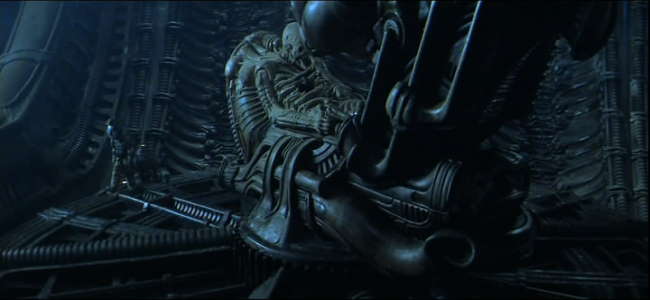
“WHAT’S THE STORY, MOTHER?” Back in 1979, something happened. A momentous event took place, one that would redefine things for years to come, its effects still lingering after all those years. Yet it is neither the none-too-peaceful Soviet meddling in Afghanistan nor the defiant revolt of Iran’s ayatollahs I’m referring to. Something else. A dark vision, a glimpse into the distant void of space. Where no one can hear you scream.
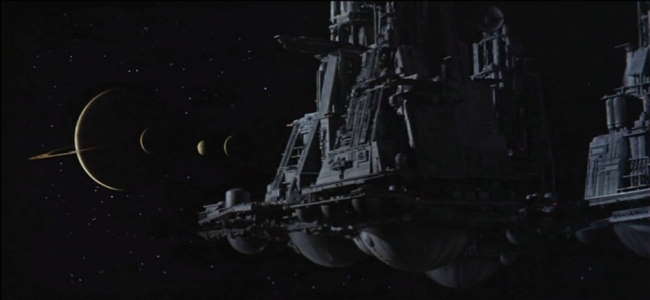
Sure no one could hear ME scream, as it would still be a couple of years before that other great moment in history- the birth of yours truly- but many others sure did when they first saw Ridley Scott’s masterpiece in all its big-screen glory. Must have been one hell of a ride. Another thing I’ve missed then… When I got acquainted with the said macabre flick, it was on a puny twenty-something inch screen and after having seen a multitude of more technologically advanced films. Nevermind. It still blew me away with the force of a 20-megaton nuclear charge. It was something new. An awakening, almost. Don’t ask me how life looked like before Alien. I can’t remember.
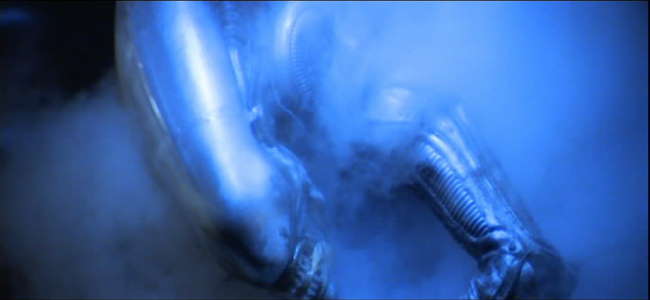
NOT OUR SYSTEM: Okay, so far so good, but there is just one tiny thing. Alien, as the name suggests, is about extraterrestial life. Not of the kind that whooshes past in gaudy flying saucers and abducts cheerleaders, but still very much not of this world. If you think cyberpunk, you obviously think implants, h4×0ring, electric sheep, that sort of thing. Surely a film about a black insect-like monstrosity eviscerating a bunch of interstellar cargo haulers does not fit in here? Well, at the risk of being summarily executed for heresy, I’ll say: yes it does. And, before you get that burning stake ready, I’ll tell you why…
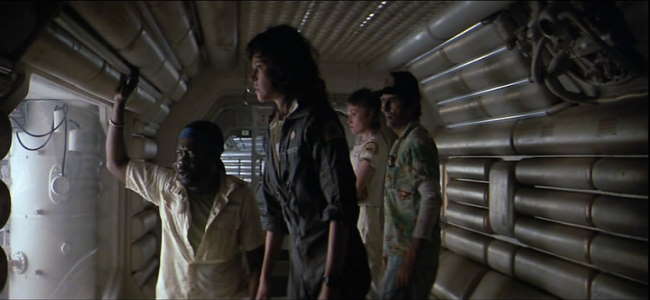
CREW EXPENDABLE: Distant future. USCSS Nostromo, a commercial spacecraft with a gargantuan ore-processing refinery in tow, its 7-man crew in deep hypersleep, encounters an unchartered backyard world from which a mysterious distress signal emanates. Mother, the ships’ computer mainframe, awakens the dreamers- Colonel Ellen T. Ripley among them- to investigate the cryptic transmission, as it is unlikely that its source is anything known to mankind… After landing on the planet’s precambrian surface, the crew discovers a derelict spacecraft… hey, you presumably know all that already anyway! Besides, for those lucky few who are still to live through the cathartic shock that is Alien, I shall try to keep spoilers to a bare minimum. Suffice it to say that they pick SOMETHING up on their unscheduled trip- and this something is just about as friendly to other organic life as H5N1 virus. Only slightly bigger. Needless to say, Colonel Ripley certainly won’t have any good memories from this particular flight…
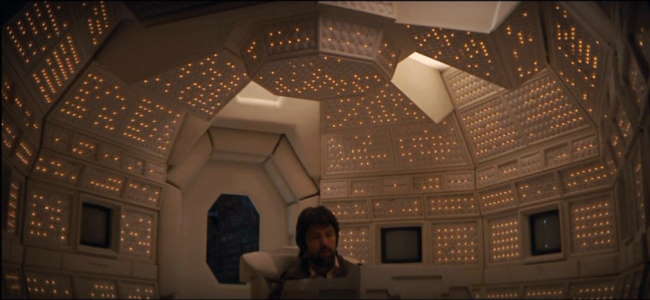
DOES NOT COMPUTE: Now the heretical part. I, regardless of how controversial a view that is, will argue that the original Alien is- you ready for this?- a cyberpunk film. True, it is not PURE cyberpunk in the way the Matrix or Ghost in the Shell are. But then again the vast majority of films reviewed here require some argument as to their cyberpunk credentials. A film does need to have ALL the relevant cyber themes either. Blade Runner and Terminator have no cyberspace, the Matrix has no androids and so forth. Same goes for the visual side. Admittedly, Alien is an uncommon hybrid, a fusion between horror and dark, cyberpunk sci-fi. But this only makes things more interesting.
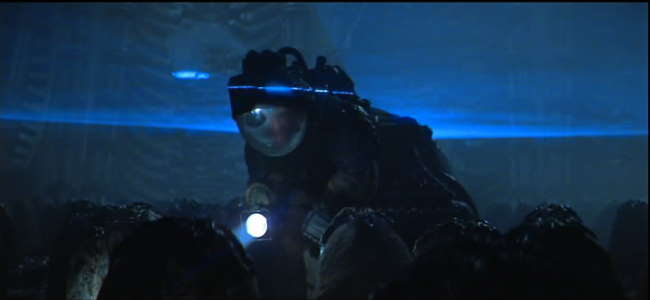
For a start, one needs to mention the existence of a shadowy entity that lurks in the background of the events in Alien (and two of its sequels)- Weyland-Yutani, a dark corporate monolith whose invisible, intangible hand guides many of the events that take place on the Nostromo and beyond. Admittedly, corporate control here is not organized in an oppressive, Orwellian kind of way. Few however would argue that its ruthless actions, removed from any ethical constraints, are any less disturbing. This fictional conglomerate is in fact not far removed from some modern-day corporations that cast aside moral and legal limitations to get what they want. Illegal deals, corruption at the highest level, worker exploitation, illegal drug trials, cover-ups- been watching the news anytime lately? Weyland-Yutani is merely the next step in evolution- a latter-day Wal-Mart, some may say. Not only willing to sacrifice Nostromo’s crew members, it is also quite fine with having its dirty work overseen by a cynical and efficient android, whose cybernetic identity only becomes apparent when a few parts come off…
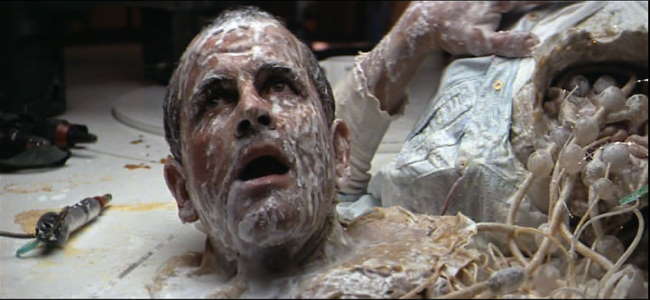
“A GODDAMN ROBOT!”: The inclusion of androids in the Alien series is another overarching cyberpunk theme. The first film does not explore the deeper implications of artificial life as much as the sequels do, but it’s still there. Here, the “artificial person” functions mostly as an extension of Weyland-Yutani’s almost limitless influence, a secretive overseer of affairs who closely follows implanted orders. But the subsequent films will explore this theme further. Rather than merely performing more identity tricks, androids take on a distinct societal role. One might quite correctly remember Bishop and Call, the other synthetics in the series, for their outstandingly vivid humanity, contradicted only by the milky white of their ersatz blood. Yet for all their moral qualities these sentient beings are condemned to an inferior- almost slave-like- role in society. And yet- for now- they accept that role with resignation, tolerating their place in the scheme of things. A programmed limitation? Hardly likely. Given their immensely strong self-awareness, one may imagine how challenging and unfair is it for an entity so humane to accept being treated as nothing more than a piece of property- so much so that Call in Alien Resurrection will at one point voice her defiance and disgust against what she was made to be. By way of comparison, in the first Terminator film the most sophisticated words uttered by our favourite mechanoid executioner are “fuck you, asshole”. See the difference?
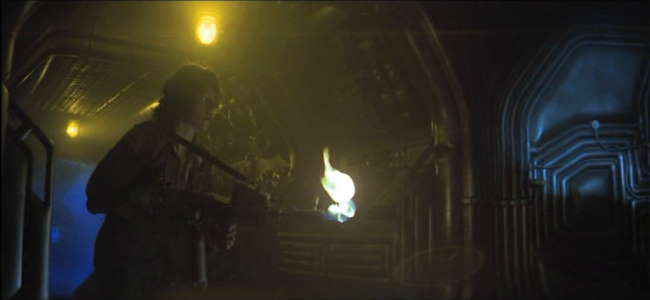
NO FURTHER ENHANCEMENT: The next important bit -the visuals. Powerful, provocative, and atmospheric, they exhibit the studied, gritty realism that has become the calling card of the series. In stark contrast to idealistic visions of the future often seen in other sci-fi films, Alien has gone down a totally different route, one that would later come do be associated with the cyberpunk genre. Case in point- the Nostromo, a far cry from sleek interstellar vessels of old. As it majestically looms into view at the beginning of the film, a mechanical cathedral emerging from the pitch black void, one can see that the film follows an entirely different canon of aesthetics. The ship is monumental, imposing through its sheer mass, intentionally unpretty. Similar approach carries on within, as we explore the craft’s unwelcoming, functional interior of labyrinthine complexity, its dimly lit, grimy corridors filled with snaking wires and exposed machinery. The crew quarters, while cleaner and more organized, seem no less depressing, exhibiting a cold, clinical look reminiscent of vintage computers. Every now and then, the screens will light up with sharply rendered readouts as the mainframes reawaken with eerie electronic chatter. As there was no CGI to fall back against, the only way to create the Nostromo’s vivid interiors was to painstakingly construct the whole set, which gives it a spectacularly tangible quality seldom seen nowadays. And one can almost feel the filmmakers pride, as the camera moves, unhurried, through these cold, industrial catacombs, studying the complex surfaces, celebrating their utilitarian crudity. Along with Blade Runner, this film has defined the core cyberpunk visual reference point for years to come.
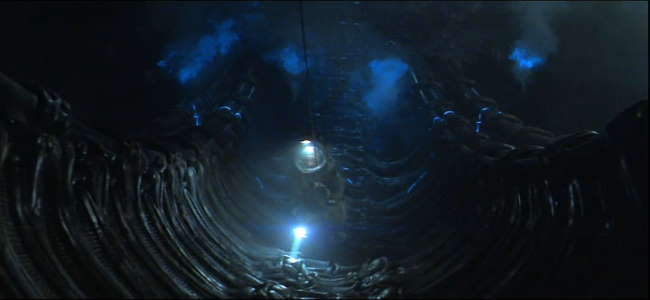
The Nostromo, however, does feel rather cozy next to the primordial desert in which it landed, a dark moonscape filled with surreal forms of bare rock. And it appears positively Arcadian compared to the infamous derelict ship, a bizarre structure, part mechanical, part organic, an otherworldly nightmare. Welcome to the dreamworld of H.R. Giger…
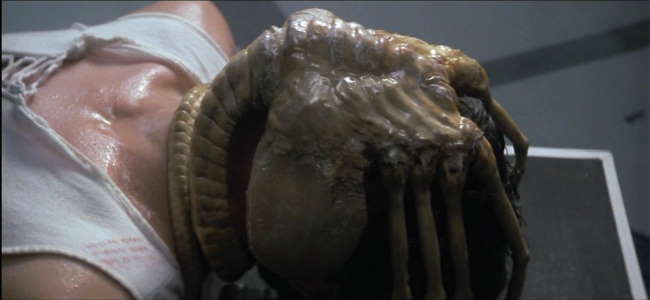
PERFECT ORGANISM: Often imitated and never bettered, Giger is a master of the grotesque. It is his wonderfully twisted mind that has spawned what is probably the greatest creature designs ever. Yet the Xenomorph is only one of Giger’s many dark, disturbing visions- many of which have caused outbreaks of controversy due to their blatant, twisted eroticism. Indeed, much of the Alien’s looks and life cycle can be seen as a perverse sexual metaphor. Yet Giger’s art is first and foremost a study of a peculiar symbiosis between man and machine, an often perverse fusion of the robotic and the organic. Next to his biomechanical mutations, most depiction of cyborg flesh appear staid and conservative. Some theories about the Xenomorph itself in fact suggest that its obscene, insectoid form was not a result of evolution, but deliberate design, the entire species intended for use as the ultimate bioweapon by a mysterious extraterrestrial race to which the forsaken spacecraft belonged. In that respect, it seems to blur the line between biological and artificial life, being something of an organic killing machine. And, it has to be added, a pretty effective one at that.
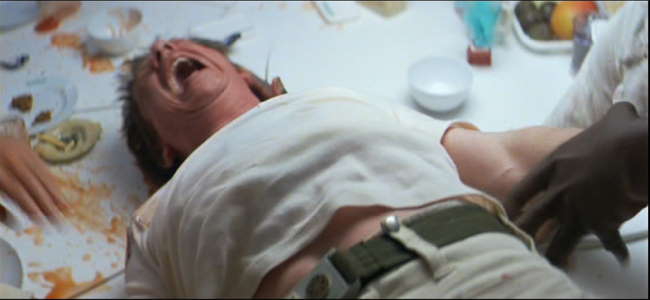
HEAR THEM SCREAM: The sound effects complete the package. From the moody, unmistakable musical score by Jerry Goldsmith to the sonic assault that we are treated to in the final sequences, as self-destruct alerts moan mournfully and explosions fill the air, this is a true masterpiece. The sound effects also have definite cyberpunk traits- the strange bleeps and machine chatter generated by the ship’s electronics are one of the best I’ve ever heard. And the Alien shrieks are almost music to my ears…
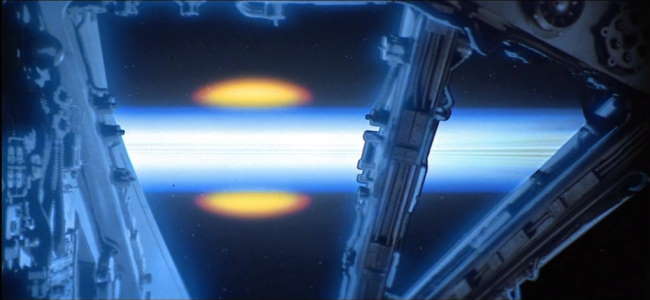
SIGNING OFF: Ripley’s confrontation with the Alien would not, of course, be the last. Three sequels have followed, each surprisingly managing to explore new themes, many of which have strong relations to the cyberpunk movement as well. Rumours of a fifth installment still linger, even though the outstanding flop that is AVP has cooled some of the enthusiasm down, and Weaver, whose evolution from a scared little girl into a seasoned Xenomorph slayer was one of the major aspects of the film, has denied involvement. We shall see. Whatever its future may be, the Alien franchise has often been seen as sitting uneasily among the more obvious cyberpunk films. Being a hybrid, it was bound be frowned upon by the purists. Yet the mere fact that it involved some non-cyber themes made many ignore the fact that it had loads of thematic links to the genre, plus its visual side is arguably closer to the orthodox cyberpunk ideal than Equilibrium, Casshern and Dark City taken together. And that it was made by the very same man who brought us a certain film involving runaway replicants. In fact the series came painfully close to gaining a sort of blessing from William Gibson himself, who has produced the original script for the third Alien film- one that, for some bizarre reason, got rejected. If it succeeded, the perception of the franchise in terms of its cyberpunk credibility might have been very different indeed.
And now if you excuse me, I’m off for a heresy trial…
More Alien Screencaps on Page 2–>>
~See movies similar to this one~
Movie Review By: SFAM
Year: 2004
Directed by: Alex Proyas
Written by: Jeff Vintar & Akiva Goldsman, based on book by Isaac Asimov
IMDB Reference
Degree of Cyberpunk Visuals: High
Correlation to Cyberpunk Themes: High
Key Cast Members:
Sonny: Alan Tudyk
Del Spooner: Will Smith
Susan Calvin: Bridget Moynahan
Dr. Alfred Lanning: James Cromwell
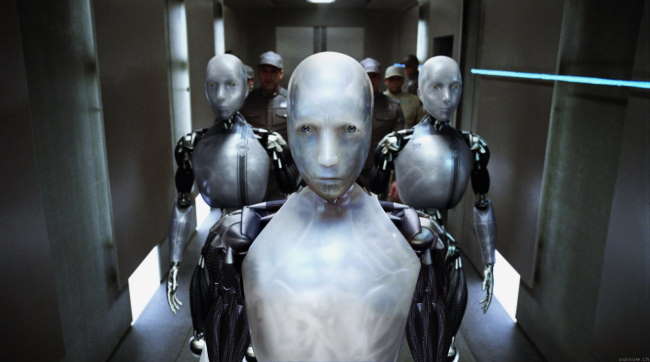
The Three Laws of Robotics
1. A robot may not injure a human being, or, through inaction, allow a human being to come to harm.
2. A robot must obey orders given it by human beings, except where such orders would conflict with the First Law.
3. A robot must protect its own existence as long as such protection does not conflict with the First or Second Law.
Overview: Superficially based on Asimov’s great collection of short stories - “I, Robot” – this movie of the same name usually sacrifices intelligent Sci-Fi for overblown summer blockbuster clichés. While Asimov fans will recognize the names of Dr. Alfred Lanning, Dr. Susan Calvin and Lawrence Robertson, they won’t recognize the characters that Proyas gives us. In yet another, “The evil robots are coming to control us” movie. I, Robot delivers eye-popping, often well over-the-top FX from beginning to end. Right at the beginning, I, Robot relays to us that they’ve set the bar low by spending the first five minutes delivering Converse Shoe and Fed-ex Delivery commercials. Still, I, Robot captures enough of the essence to make it enjoyable cyberpunk viewing. Asimov’s three rules are still in play here, and Sonny, the robot, actually makes it interesting.
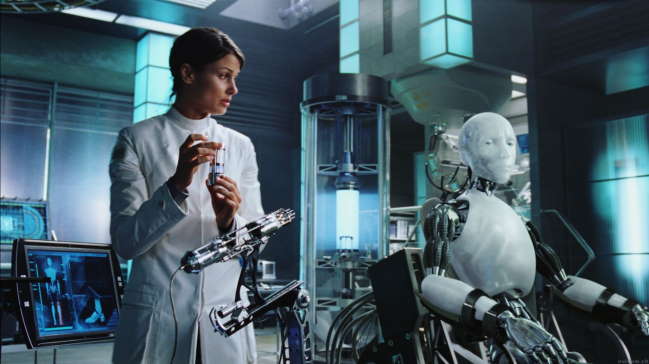
The Story: In the near future (2035), robots are a pervasive fact of life, and serve humans in a variety of capacities. US Robotics, maker of the fabled “NS” series of robots is just about ready to release their greatest innovation, the NS5 robots. NS5 robots are the most lifelike to date, and are destined to replace the ultra-reliable but outmoded NS4 model. The NS5s are guaranteed to stay new by receiving daily updates from US Robotics’s master AI system, “V.I.K.I.”
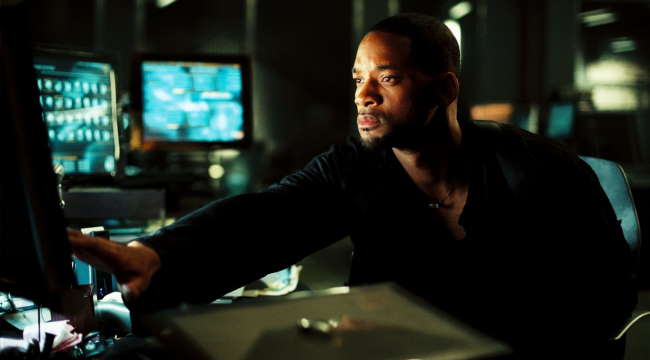
The week of the release, Dr. Alfred Lanning (James Cromwell), the founder of modern robotics dies in an apparent suicide. He leaves a clue behind for former patient and police officer Del Spooner (Will Smith). Del Spooner has reasons to hate and mistrust robots and immediately suspects foul play. US Robitics CEO Lawrence Robinson (Bruce Greenwood) is suspicious looking, and things just “feel” right.
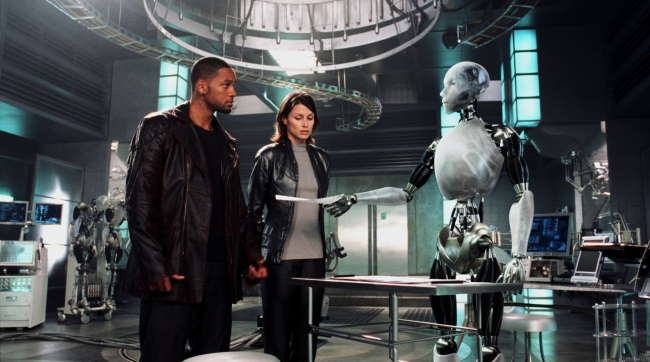
Assisted by robot psychologist, Dr. Susan Calvin (Bridget Moyanahan), Del finds an NS5 robot named Sonny, who appears to have freewill developed life-like features – so much that Del suspects Sonny of having killed Dr. Lanning. In following the breadcrumbs, Dels fears are realized – the robots do not seem to be adhering to the thee Laws of Robotics. Now they must race to uncover the real nature of the plot before the trap is sprung.
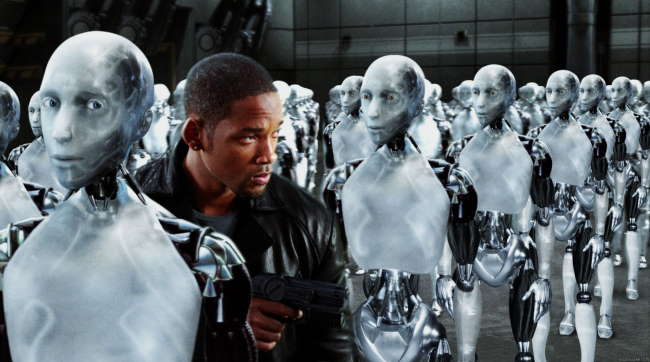
Will Smith Plays “Will Smith”…Again: You know the role – cocky, argumentative, underdog tough-guy cop – Be it MIB, ID4 or I, Robot, Will Smith plays the same old Will Smith. I, Robot was clearly green-lighted to bring in the teens to the seats over the summer – Will Smith is the guy to do this. Will Smith and massively cool FX = ROI. Unfortunately, it also engenders a far crappier story. Had we gotten an introspective no-name person in Smith’s role, we might have had a significantly higher degree of realism. But then again, realism would imply that things like the overblown US Robots Truck bashing scene wouldn’t have been included.
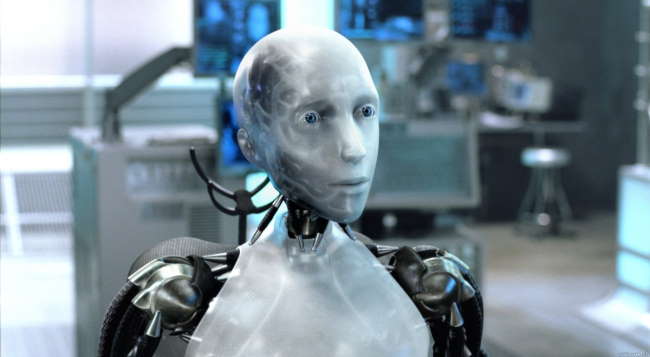
Sonny: If not for Sonny, I, Robot would be almost unwatchable. Sonny (voiced by Serenity star, Alex Tudyk) provides us an investigation into android humanity similar to Star Trek’s Data in his better moments. While some of it comes off as sappy, Sonny’s questioning of his right to exist, and more interestingly, his hopes that others consider him a being instead of an it provide the best moments of the movie. One can only wonder how much better I, Robot would have been if this aspect of the movie was highlighted vice the focus on Will Smith and the overblown FX scenes.
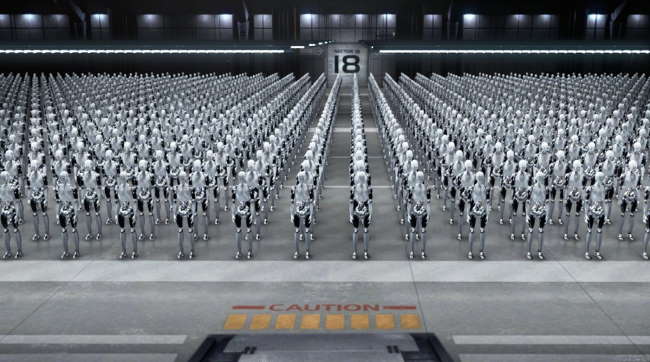
“There have always been ghosts in the machine – random segments of code that have grouped together to form unexpected protocols. Unanticipated, these free radicals engender questions of free will, creativity, and even the nature of what we might call the soul. Why is it that when some robots are left in the dark they will seek the light? Why is it that when robots are stored in an empty space they will group together rather than stand alone? How do we explain this behavior? Random segments of code? Or is it something more? When does a perceptual schematic become consciousness? When does a difference engine become the search for truth? When does a personality simulation become the bitter moat of the soul?”
Evolution of The Three Laws: I, Robot touches on some interesting questions concerning the three laws. If, taken to their logical extreme, do the laws imply, similar to Colossus: The Forbin Project, that machines should consider removing our freewill in order to protect us? Also, given a set of operating conditions that include the ability to learn from the environment, are we truly sure that machines would not eventually develop sentience and freewill? This is especially problematic when science has yet to deliver a definitive statement on how this comes about.
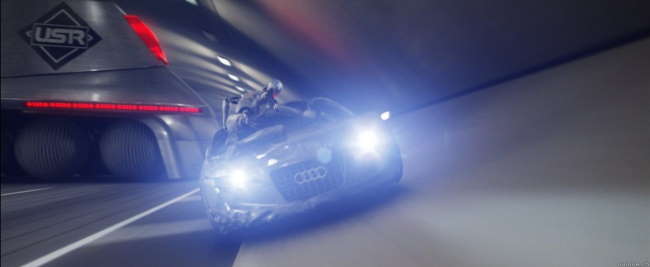
The FX: Yes, I, Robot delivers awesome android FX – continually so, in fact. The mandatory overblown chase scenes, massive explosions and lots of gun fighting are all there, but so are the robots. And the robots are simply amazing. Their facial expressions are lifelike, their exoskeleton muscles look believable, and their demeanor seems perfect. However, their cartoon-like ability to jump as high and far as they like is well past over-the-top. Worse, not all of the NS5s are equal, as near the end they transform into bumbling fools, where an army of them seems unable to stop two humans in possession of guns that never run out of ammo.
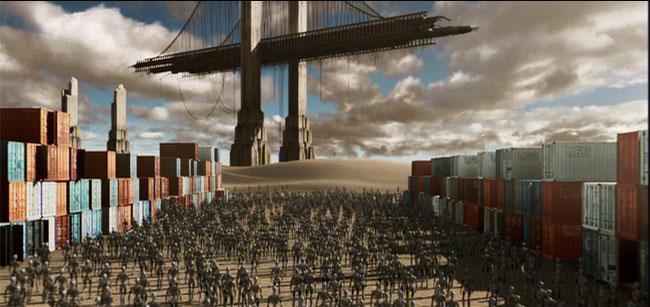
The Bottom Line: One wonders how great I, Robot could have become had the studios given Dark City director Proyas more of a free hand in its development. Instead, I, Robot is a summer blockbuster first, and an interesting cyberpunk movie second. Still, Sonny and the robot FX raises I, Robot to be more interesting and enjoyable than it has rights to be. The performances of the leads are pretty much all lackluster – make no mistake – Sonny is the star here, and dominates the screen during every appearance he makes. Normally I give overblown summer blockbusters with great FX five or six stars – Sonny, and the wonderful ending visual makes I, Robot deserve a bonus star.
~See movies similar to this one~
|






































































































